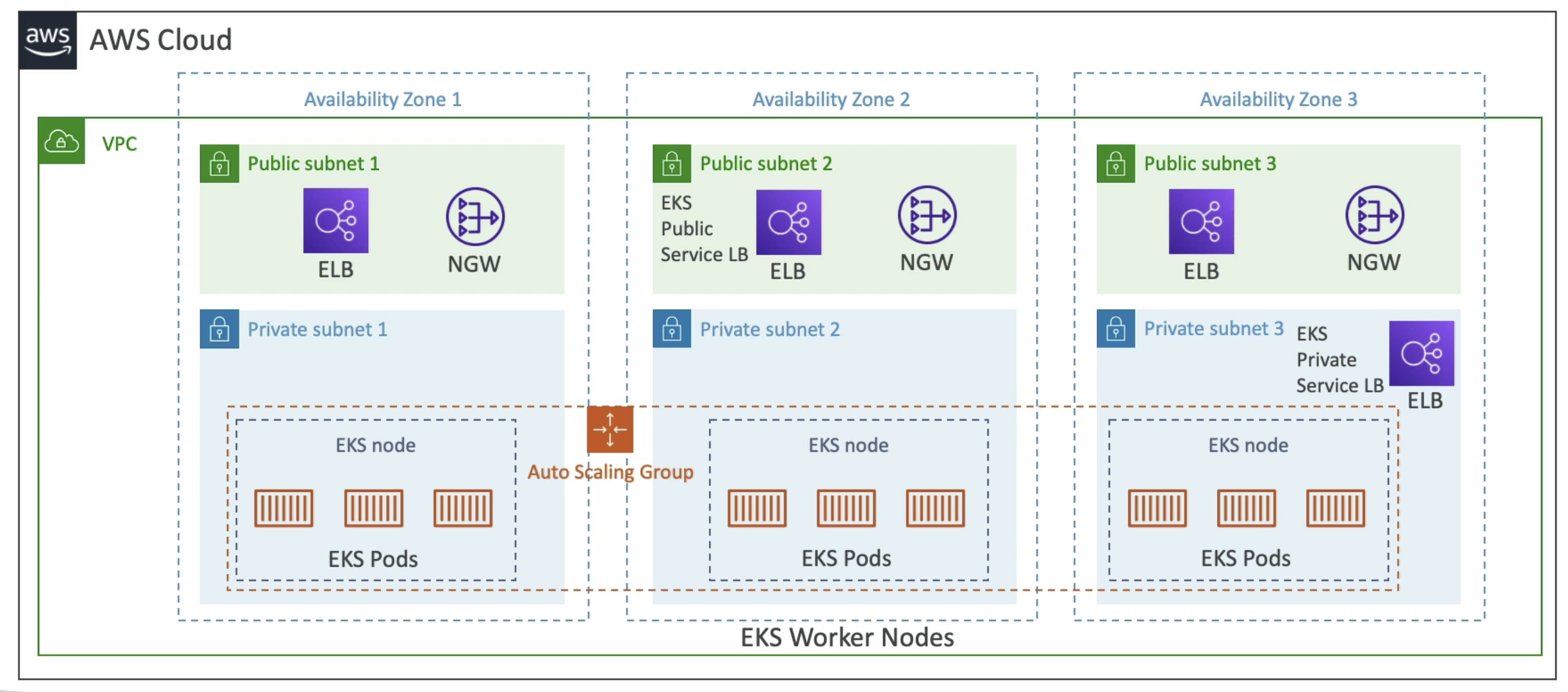Other AWS Services
- Web Socket Support: AppSync, ALB, API Gateway
Serverless = Invisible Server for Developer
Deploy code or function without creating/provision a server
Serverless in AWS:
- Lambda, API Gateway, Cognito, Step Function
- Dynamo DB, Aurora,
- S3, EFS,
- Fargate
- SNS, SQS, Kinesis FireHose,
Serverless Application Model(SAM)
Framework to develop deploying serverless application on
Cloudformation
- Use
YAMLto define configuration and quickly deploy Serverless app - Built on top of cloudformation
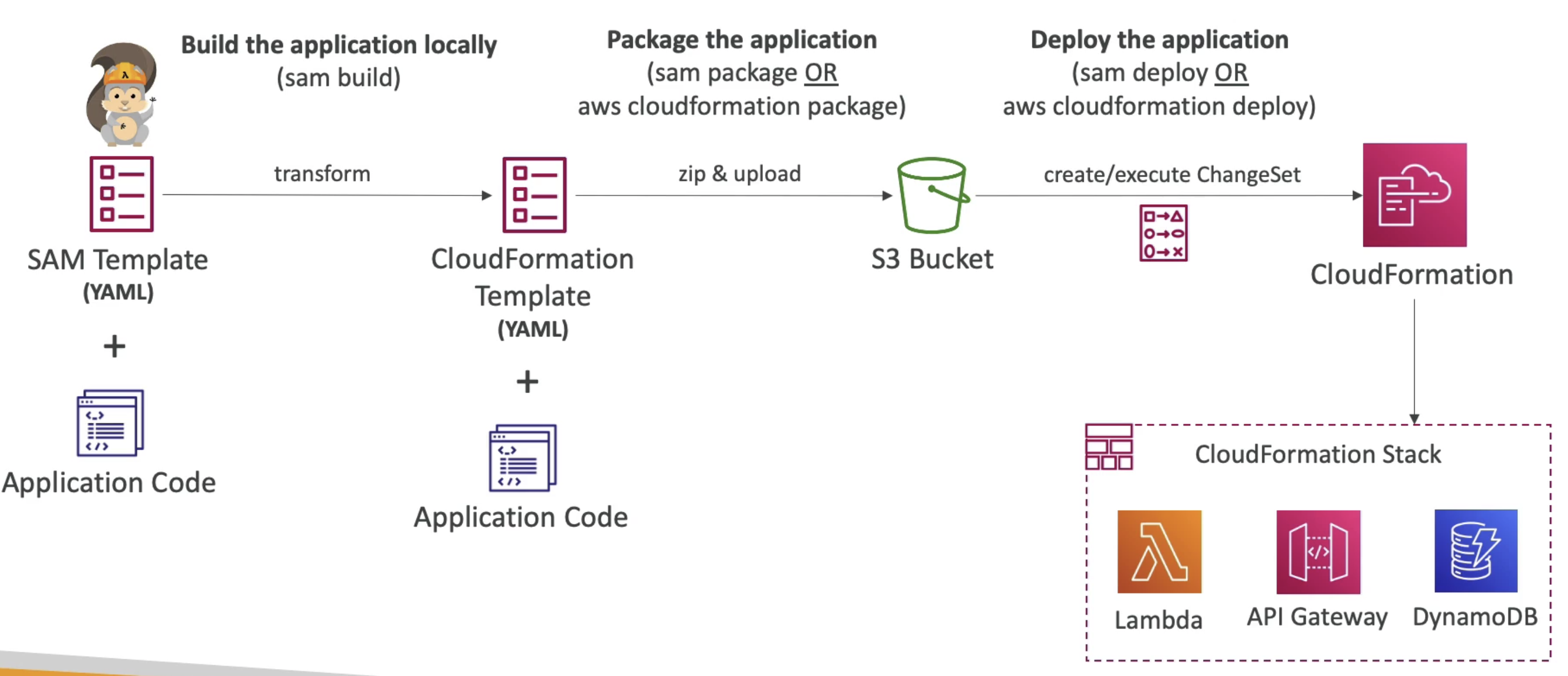
SAM Recipe
SAM template gets transform into Cloudformation template
- Transform Header:
AWS::Serverless-2016-01-31indicate its a SAM tamplate for Cloudformation to transform into cloudformation template
- Write & run locally:
- Lambda:
AWS::Serverless:: Function - Dynamo DB:
AWS::Serverless:: SimpleTable - API Gateway:
AWS::Serverless:: Api
- Lambda:
- Build: Fetch dependencies to build deployment artifact
sam build
- Package & Deploy:
sam package/aws cloudformation package: package & upload to S3 , generate CF Templatesam deploy/aws cloudformation deploy: Deploy to CLoudformation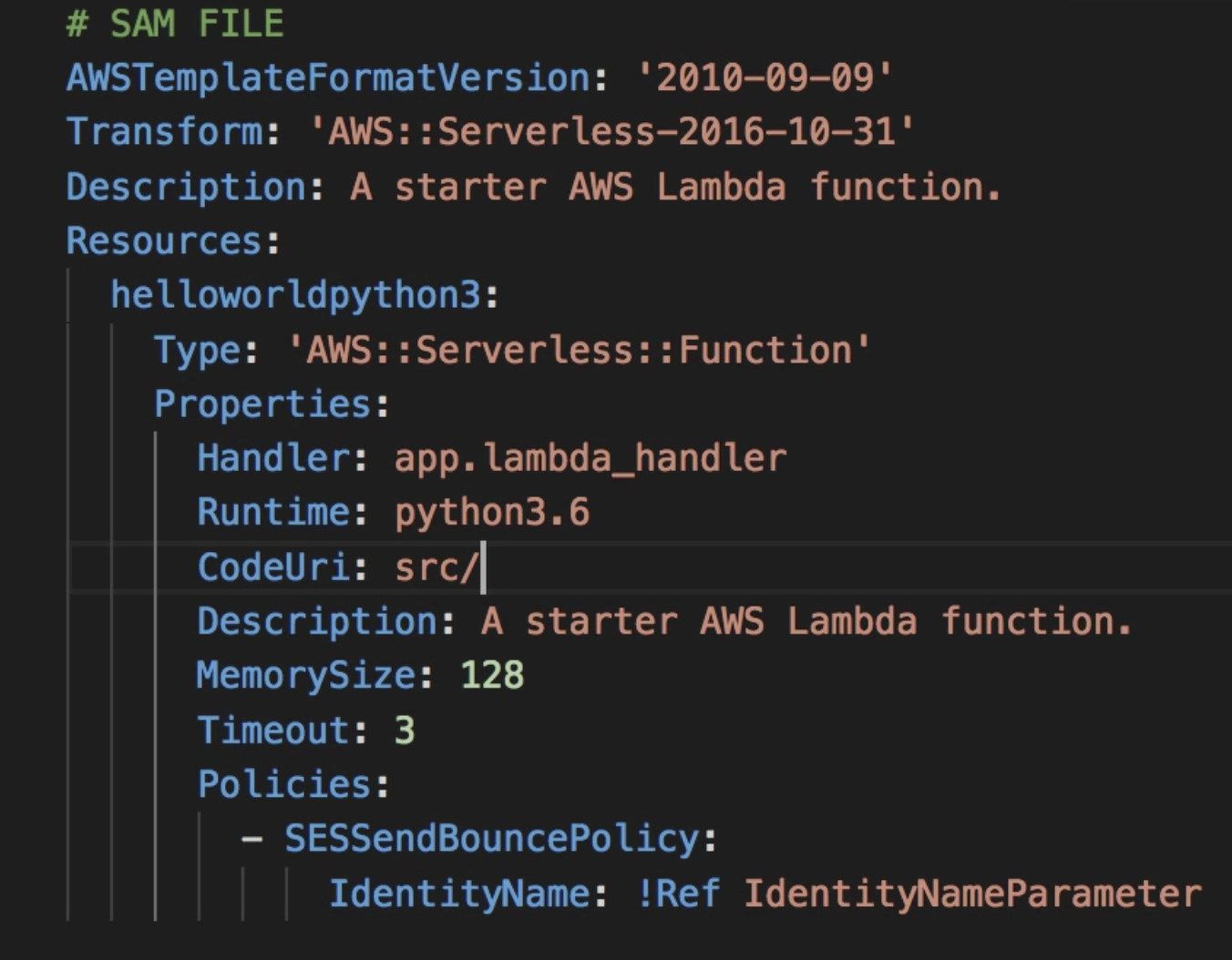
SAM CLI+ AWS ToolKit
Allows you to debug your Lambda functions locally, inspect variables, and execute code line-by-line.
SAM CLI Run Lambda function locally and debug them before deploying them on AWS
AWS ToolKit: IDE Plugin allows to build, test debug, eploy & invoke lambda functions
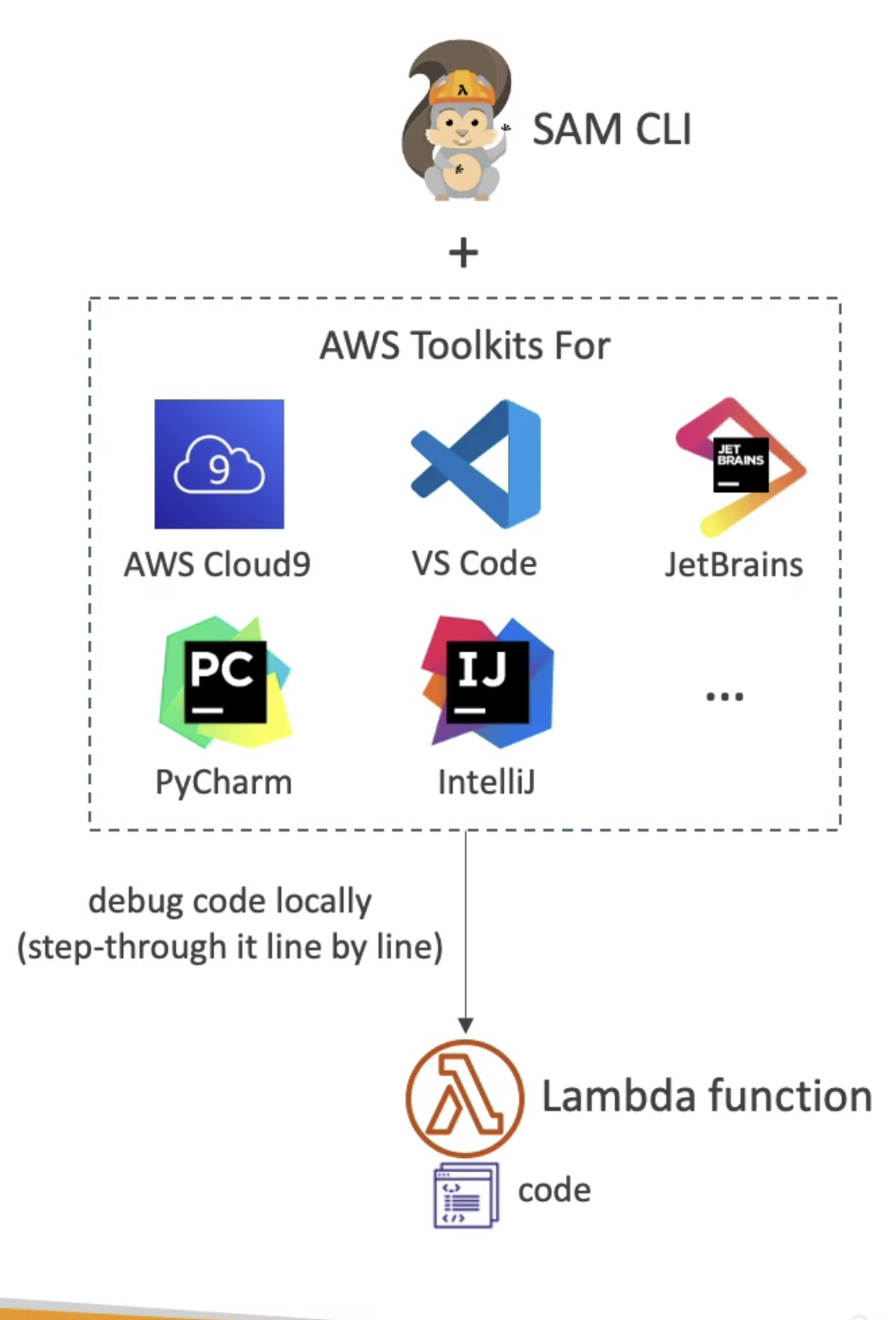
SAM Policy Template: List of template to apply permission to Lambda Function
Transform into IAM role on cloud formation
- S3ReadPolicy: read from S3 Bucket
- SQSPollPolicy: Poll on SQS
- DynamoBCrudPolicy: CRUD on DynamoDB
Testing using Codedeploy
Can use Codedeploy to deploy Lambda function
- Allow traffic shifting to new Lambda Function Steps:
- Pretraffic Hook: Codeploy run lambda function to test V2
- Traffic Shifting: Direvrt traffic to V2
- Post Traffic Hook: RunAnother Lambda function to test V2 after traffic is shifted
- Remove the V1 Lambda
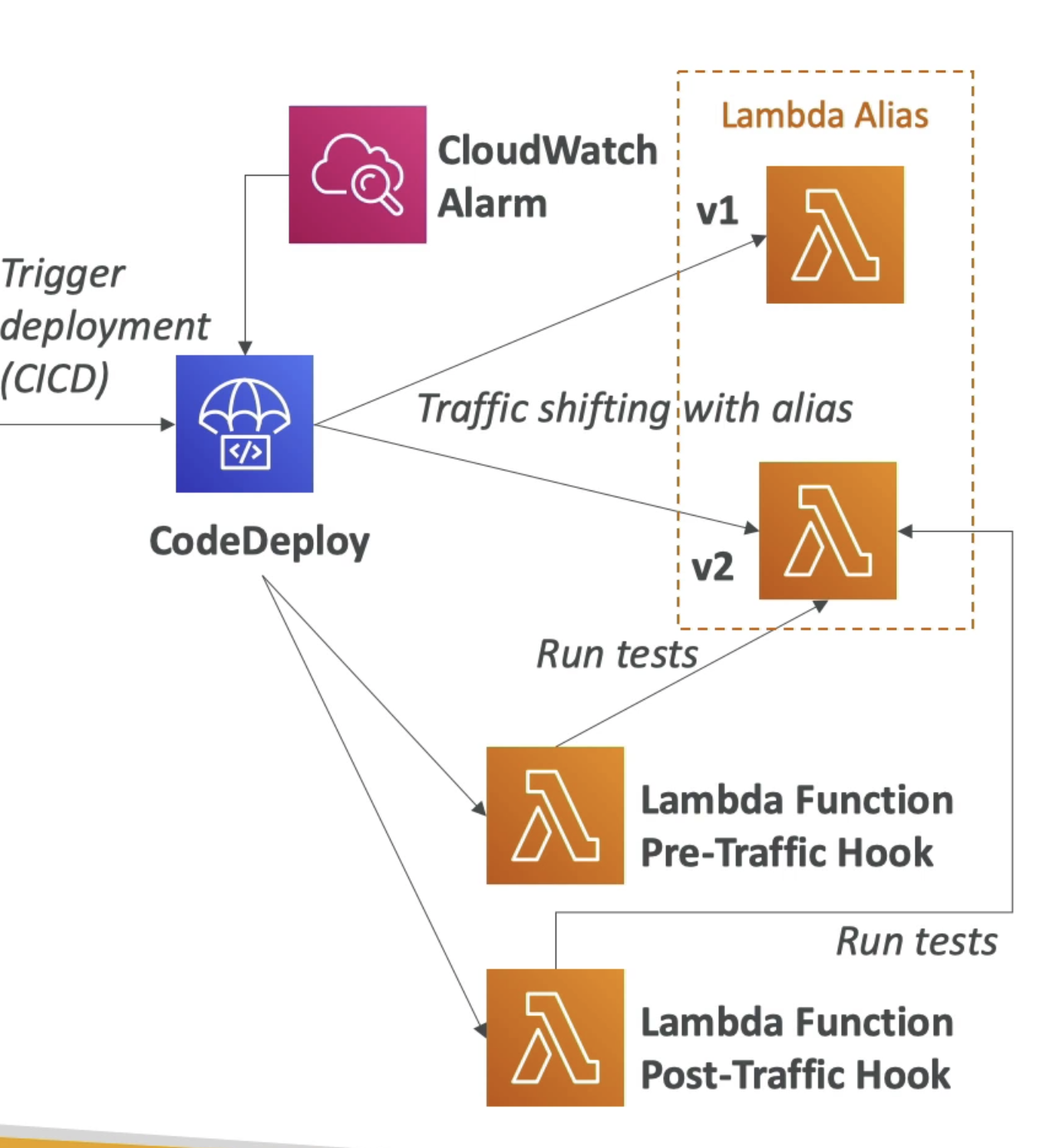
Serverless Application Repository(SAR)
Managed repository for Serverless Applications allows share Serverless applications packages using SAM with other AWS accounts
- Build & publish serverless applications shared by organizations
- Application settings can be configured using Environment Variables
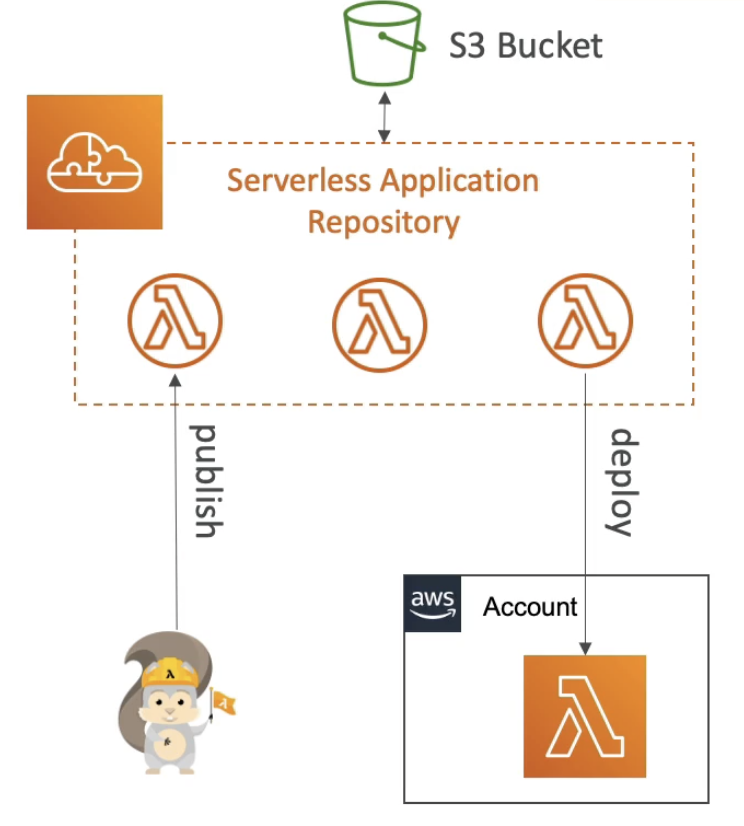
AWS BATCH
Batch processing servicing to run batch job
- Dynamically run EC2 instance to execute Batch Jobs
- Batch Job defined as Docker Image
- Automatically assign resource to EC2 instance
AWS Lambda:
Service that lets you run code without needing to provision or mange server
- You can configure your Lambda function to pull in additional code and content in the form of layers.
-Quick Process with 15 Minute
- Scale to finish task with
15 Minutes - Event Driven: Function gets triggered over an event.
- Multiple programming language supported
- Node JS, Python, Java, C#, Golang, Ruby, Runtime
- Easy to get more resource (
10 GB RAM) - Pricing is good compare to running and scaling EC2
- Pay per call & duration of execution
- Good idea to deploy a CloudWatch Alarm that notifies your team when function metrics such as
ConcurrentExecutionsorInvocationsexceeds the expected threshold - Example: Resize Images, Check for NSFW images
Concurrency:
- Reserve Concurrency: Allocate & limits the maximum concurrency for the function
| Lamda | Batch job |
|---|---|
| Time Limit 15 Minute | No time limit |
| Limited Runtime Supported | No run time |
| Limited Disk Space | No limit as uses EBS |
| Serverless | Use EC2 instance managed by AWS |
Lambda Container Image:
Start Docker container with Lamda Runtime API
-
Must build form AWS Lambda base image by AWS
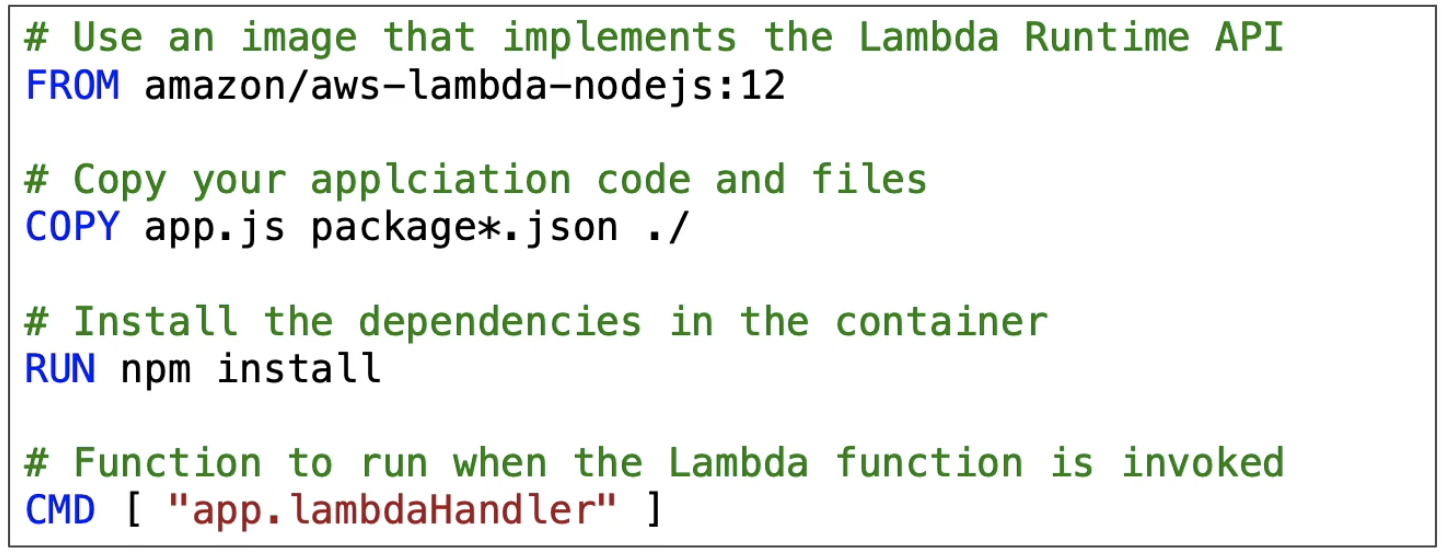
-
Pack large & complex dependencies as Image
-
Lambda Run Time Interface Emulator: test Lambda container images locally
-
Allow deploying image up to
10GBon ECR
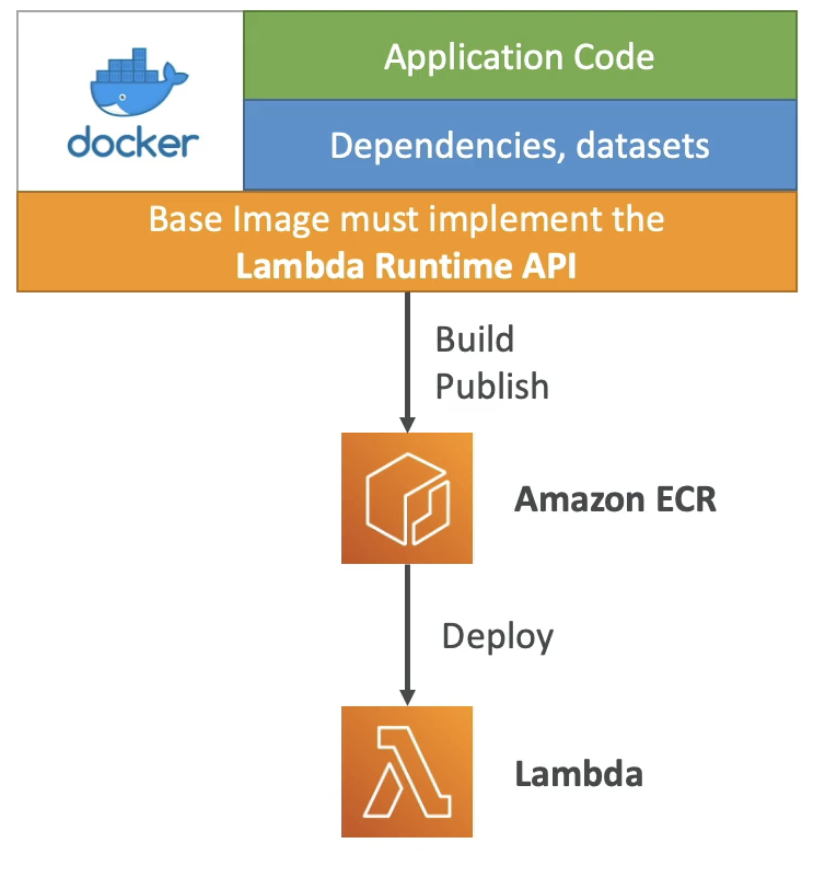
Lambda Layer:
A layer is a ZIP archive that contains libraries, a custom runtime, or other dependencies.
- Limit: A function can use up to
5layers at a time. - You can use libraries in your function without needing to include them in deployment package to keep deployment package small, which makes development easier.
- Use Case:
- Enable Custom Runtime: Example C++ & Rust
- Reuse Dependencies
- Create Small package

Lambda External Dependencies
Package code + dependencies in zip file & upload it to Lambda
- Size must be
< 50MBelse use S3 - Dependencies must compile & work on Amazon Linux AMI
- AWS SDK come with Lambda so no need to add it as dependency
Limit Per Region
-
Execution
- Environment Variable:
4KB - Storage:
512 MB Temp - RAM:
128MB-10GB(1MB Increment) - More RAM -> More vCPU, 1790MB RAM -> 1 Full vCPU
- Time:
3 SecDefault - to Max900 Sec(15Min) - Concurrent:
1000
- Environment Variable:
- Deployment
50MBcompressed250MBUncompressed(Code+ Dependency)- The total unzipped size of the function and all Layers can't exceed
250 MB.
Lambda Integration
- API Gateway -> Rest APi using Lambda
- Kinesis-> Data Transformation on the fly
- DynamoDB-> Trigger on DB Events
- S3 -> Create Thumbnail or extract MetaData
- CloudFront-> Lamda@Edge
- EventBridge/ CloudWatchEvent-> React to Events
- CloudWatch Log-> Stream Logs
- SNS, SQS-> React to SNS
- Cognito -> React to User Login
Lambda Synchronous Invocation
Return return right away along with errors
- Supports: CLI, SDK, ALB, API Gateway
- Error handled by Client

Supported Synchronous API:
Lambda@Edge
Deploy alongside app on CDN location to change request at origin
User <---> Cloudfront <----> Origin

- ViewerRequest: Change Request to CloudFront
- ViewerResponse: Change Response from CloudFront to Viewer
- OriginRequest: Change Request from CloudFront to Origin
- OriginResponse: Change Response from Origin to Cloudfront
Other Supported Synchronous API:
- ALB
- API Gateway
- Lambda@Edge
- S3 Batch
- Cognito
- Step Function
- Lex, Alexa
- Firehose
Lambda Asynchronous Invocation
- Auto retry 3 times: Immediately, 1 Minute After, 2 Minute After
- Make use of Queues
- Speed up processing on scale
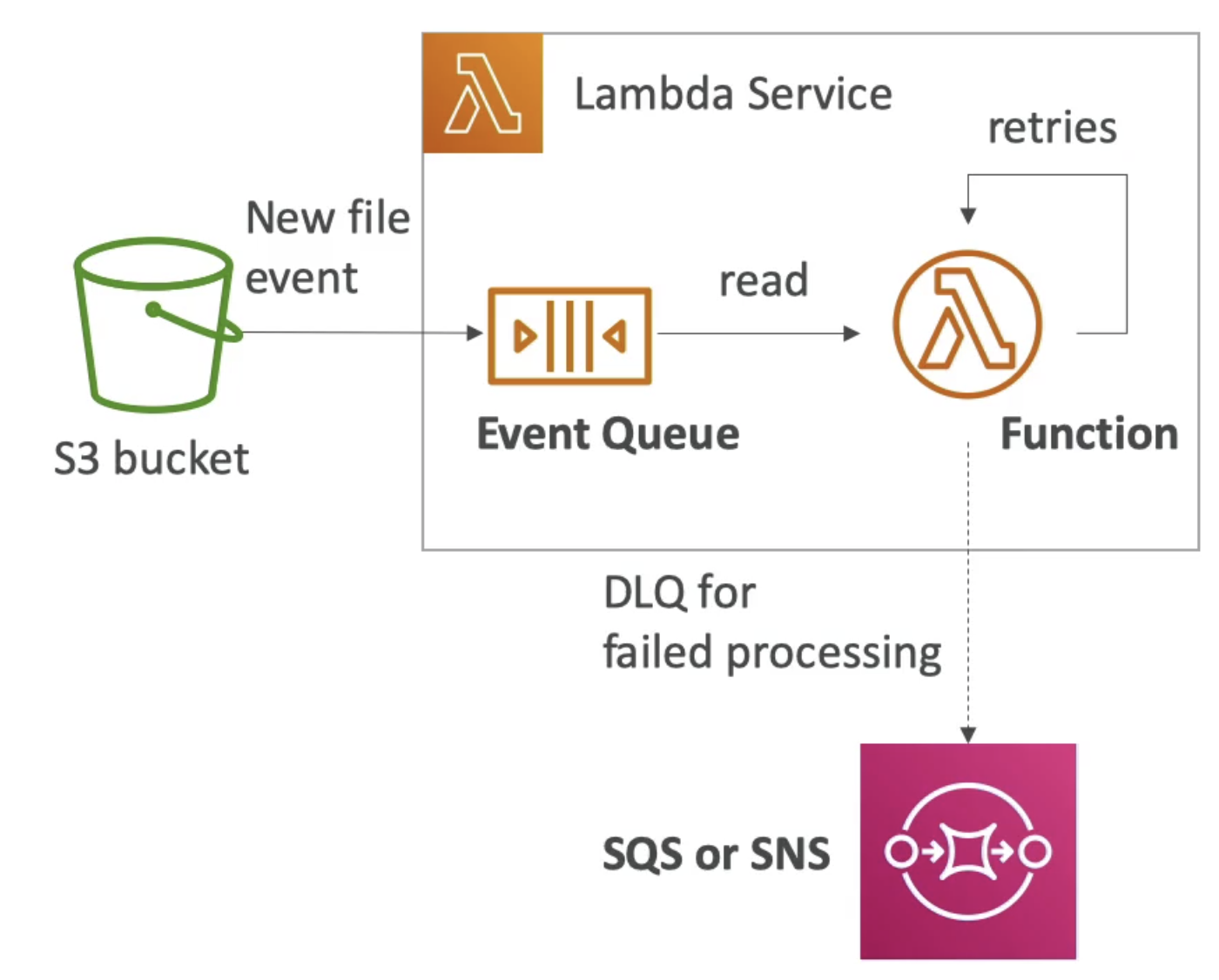
Asynchronous Supported API:
S3 event notification:
Invoke Lambda when S3 Objects are modified
- Enable Versioning of object to get notification of all S3 object modifications
- Trigger lambda directly
- SQS-> Lamda-> DLQ
- SNS-> SQSs->Lambdas`
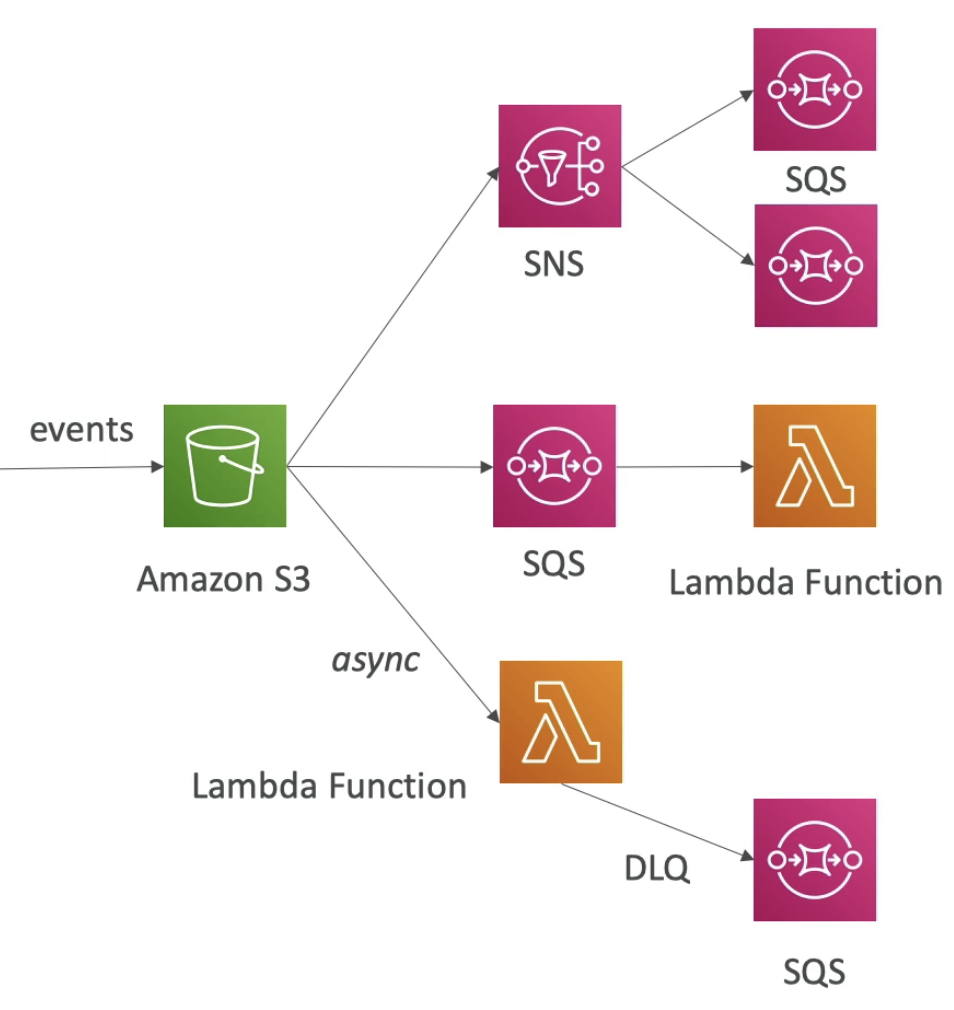
Other Asynchronous Supported API:
- Cloudwatch Event/ Event Bridge
- Code Commit
- Code Pipeline
- SNS
- SES
- Cloud formation
- IOT
- Config
Lambda Destinations
Send Failed or success events for further processing
- Support:
SQS, SNS, Lambda, Cloudwatch Events
Event Source mapping
Used for discarded Events which cant be processed
- Types
- Streams:
Kinesis Data Stream, Dynamo DB Stream- Data is read from
Shard - Data persist : other API can read data at same time
- Shard can be batched & run in parallel for faster processing
- Error Handling:
- Data is read from
-
Lambda:
SQS, SNS - Data is polled from Sources
API GATEWAY
Expose Lamda to Client Machine via
REST API & WebSocket
-
Fully managed service to create, publish, monitor API
-
Protocol: REST API & WebSocket support
-
Serverless & Scalable
-
Auto Versioning of API to support old API users
-
Stages: Support Multiple Environment dev, prod -
Transform & validate request response on API
-
Swagger/OpenAPI 3.0support to import & export predefined API -
Can Generate SDK & API Specification
-
Cache API Response: reduce load on backend
- Cache TTL:
5 MinutesDefault, Min 0, Max 1 Hour - Expensive so use in prod only
- Can be defined per Stage
- Can be defined per Method
- Can be encrypted
- Size
.5GB-237GB - Invalidate cache on UI or use
header:CacheControl:max-age=0with proper IAM authorization
- Cache TTL:
API Gateway Integration:
- Lambda: Expose REST API backed by Lambda
- HTTP End Point: Internal HTTP PI from on premise server, ALB etc
- Expose Any AWS Service: Start Step FUnction, post message to SQS
Mapping Template:
Map Request-Response Data Map
- Can modify request/response, parameters,body contents, add headers
- Can rename variables and map them
- Can filter Response before sending back to client
- Use case: Connect SOAP API to JSON

API Gateway Integration Type
Ways to integrate API gateway with Backend
- MOCK
- API gateway send response without ending request to Backend
- No work needed on backend side
- HTTP/AWS:
- Need to configure integration request & integration response using
Mapping Template
- Need to configure integration request & integration response using
- AWS_PROXY No Mapping Template. Request/Response send to/from to client send directly without any modification. backend handle the logic
- HTTP_PROXY: No Mapping to HTTP end point.
API Gateway Deployment : End Point Type
- Edge Optimized(Default)
Route through Cloudfront edge location
- for global client
- The API Gateway lives in only one AWS Region where it was created. But can be accessed from any Cloudfront edge location
- API requests are routed to the nearest CloudFront Edge Location which improves latency.
- Best for geographically distributed clients.
- Regional
For client in same region
- Manually distribute using Cloudfront
- Private
Accessible within a VPC
- Use interface VPC endpoint to distribute within a VPC
Logging & Tracing
- Cloudwatch Logs: Enable logging at Stage Level API level logging: ERROR, DEBUG, INFO
- XRay: Tracing information
- Cloudwatch Metrics: Monitor API calls per Stage
cacheMissCount: bad cachingcacheHitCount: good cachingcount: API count/SecIntegrationLatency: Time taken by backend integration to response to APILatency:IntegrationLatency+ API gateway delay4XX: client side error400 Bad Request403 Access Denied429 Quota Exceed
5XX: Server side error502 Bad gateway: proxy integration did not respond503 Service UnavailableBackend down504 Integration FailureAPI gateway failed to respond withing 30 second
Throttling
Soft Limit10k Request/Second/Account- Error Code: 429 Too Many Request:
- Handling:
- Exponential Backoff
- Set Stage Limit & Method Limit
- Usage Plan to create API plans & API Limits for customer
API Gateway Security
1. IAM
- Provide access to AWS resourceWithin AWS Account
- Leverage
SigV4to sign & place credentials in header - Handle both AUthentication & Authorization
- Auth:
IAM| Authorization:IAM Policy - Can be combined with Resource Policies
Resource Based Policy:JSON Policy Document Authorize API gateway to invoke Lambda Function Gateway level
- Filter Ip address

2. Lambda Authorizer(Formally Custom Authorizer)
Token base Authorizer but require more involvement
- Great for 3rd party token
- Pay per Lambda invocation but we can cache response
- Auth:
External| Authorization:Lambda Function

3. Cognito User Pool
- Use FB, Google login
- No need to write any code: automatically verified using CUP connection token.
- Auth:
CUP| Authorization:Backend/API Gateway
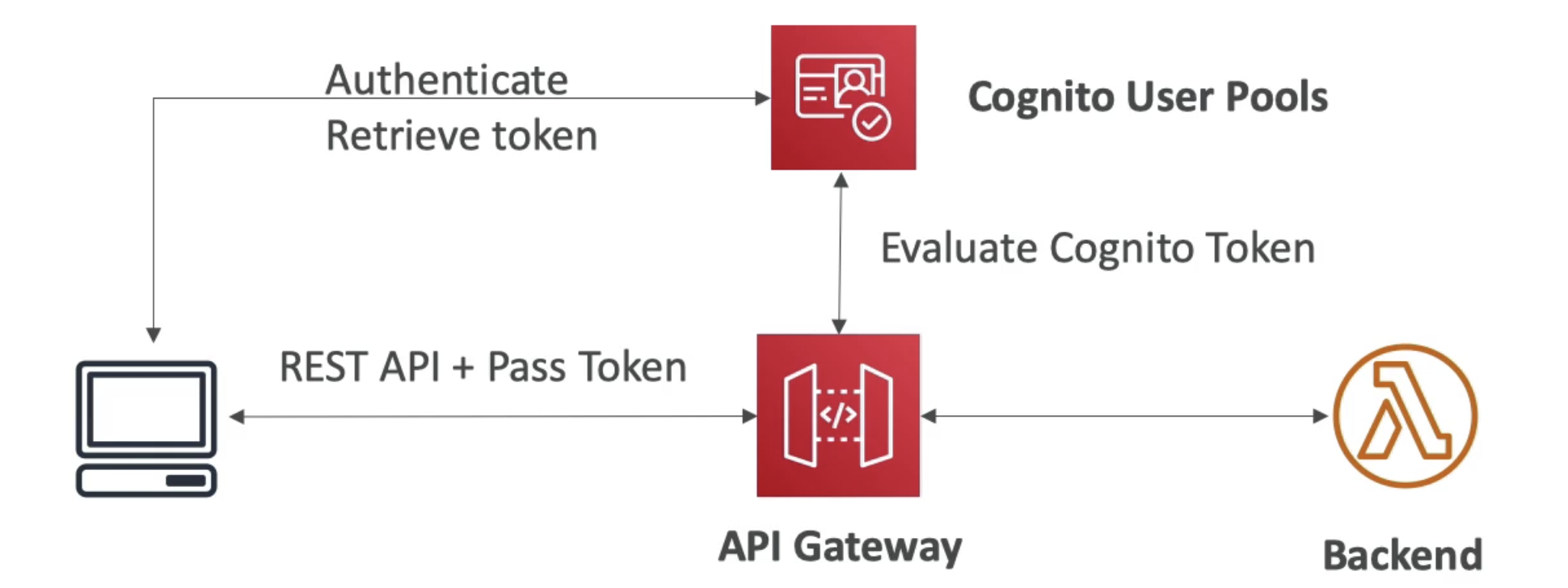
Deployment Stage
- API wont work without deploying changes to stage
- Can be roll back because all history is kept
- Each stage have own configuration
- Use ful for deploying new versions or managing dev/prod/test environments
Stage Variables
- Environment variables for API Gateway pointing to reconfigurable environments
- HTTPS End Point
- Pass to Lambda Context object
Canary Deployment Test Beta API by routing partial traffic to new API Version
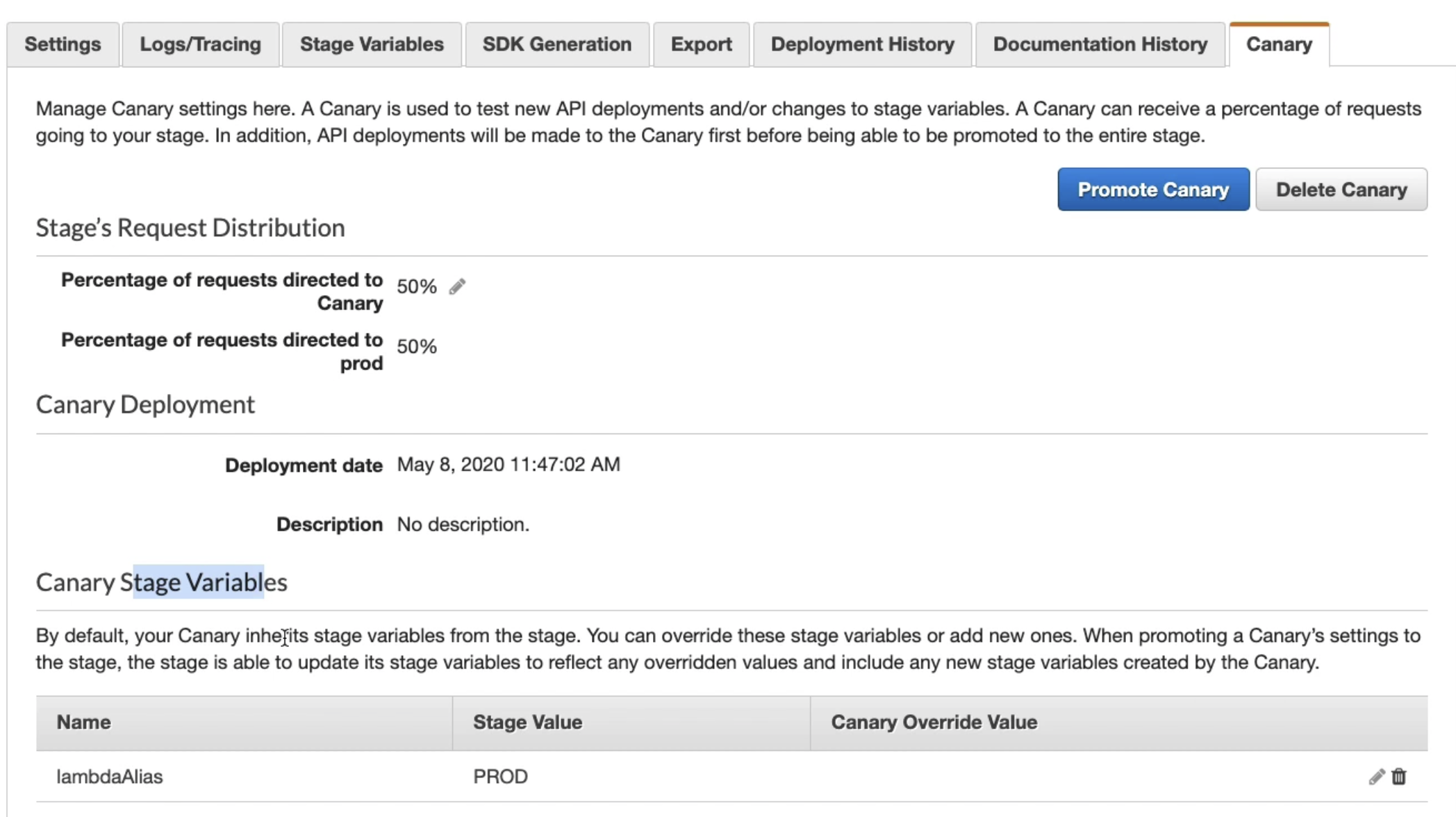
Simple Work Flow (SWF)
Coordinate work on EC2 instance with built in human interaction
- Older and not supported anymore
- Deprecated in favour of Step Function
- Use if you need: external signals to intervene, or child processes to return values to parent processes. For decoupled architectures.
Step Function
Lets you coordinate multiple AWS services into Serverless workflows.
- Design and run workflows that stitch together services such as AWS
Lambda, AWSGlueand AmazonSageMaker. - Can add jobs in parallel, sequence, time out & error handling
- Orchestrate multiple
Lambdafunctions and wait for the result of all of them before making a final decision. - Use
JSON State machineto sequence Lambda Functions to communicate with multiple resources - Replacement of SWF
Types of Step Function
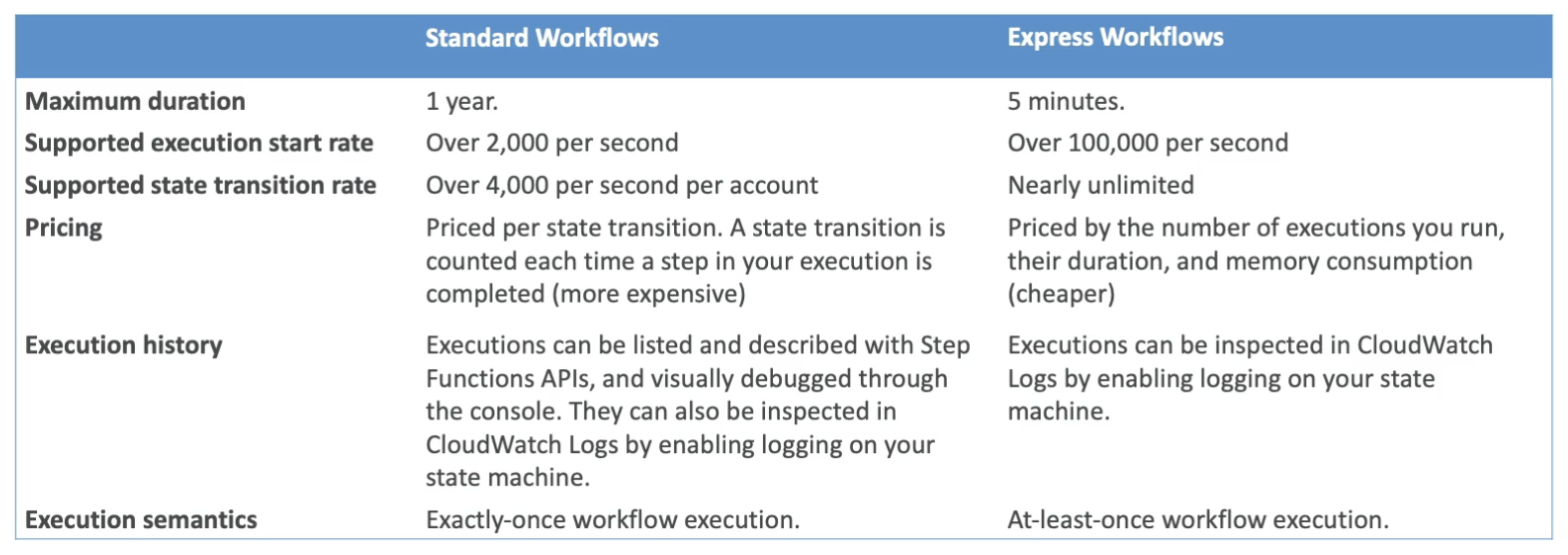
Task State
Steps in a step function to invoke AWS service
- Choice State: condition check
- Fail/Success State : stop execution
- Pass State: pass input to output
- Wait State: timeout, delay with Maximum timeout
1 year - Map State: iterate state
- Parallel State: parallel execution
Error Handling:
Predefined Error Codes checked with ErrorEquals in Retry or Catch
States.ALL: any error nameStates.Timeout: no heart bean received or time exceededStates.TaskFailedStates.Permission
Retry: repeat execution
ErrorEquals: MAtch for error typeIntervalSecond: delay before retryBackOffRate: delay multiplier for next retryMaxAttempt: Max Retries
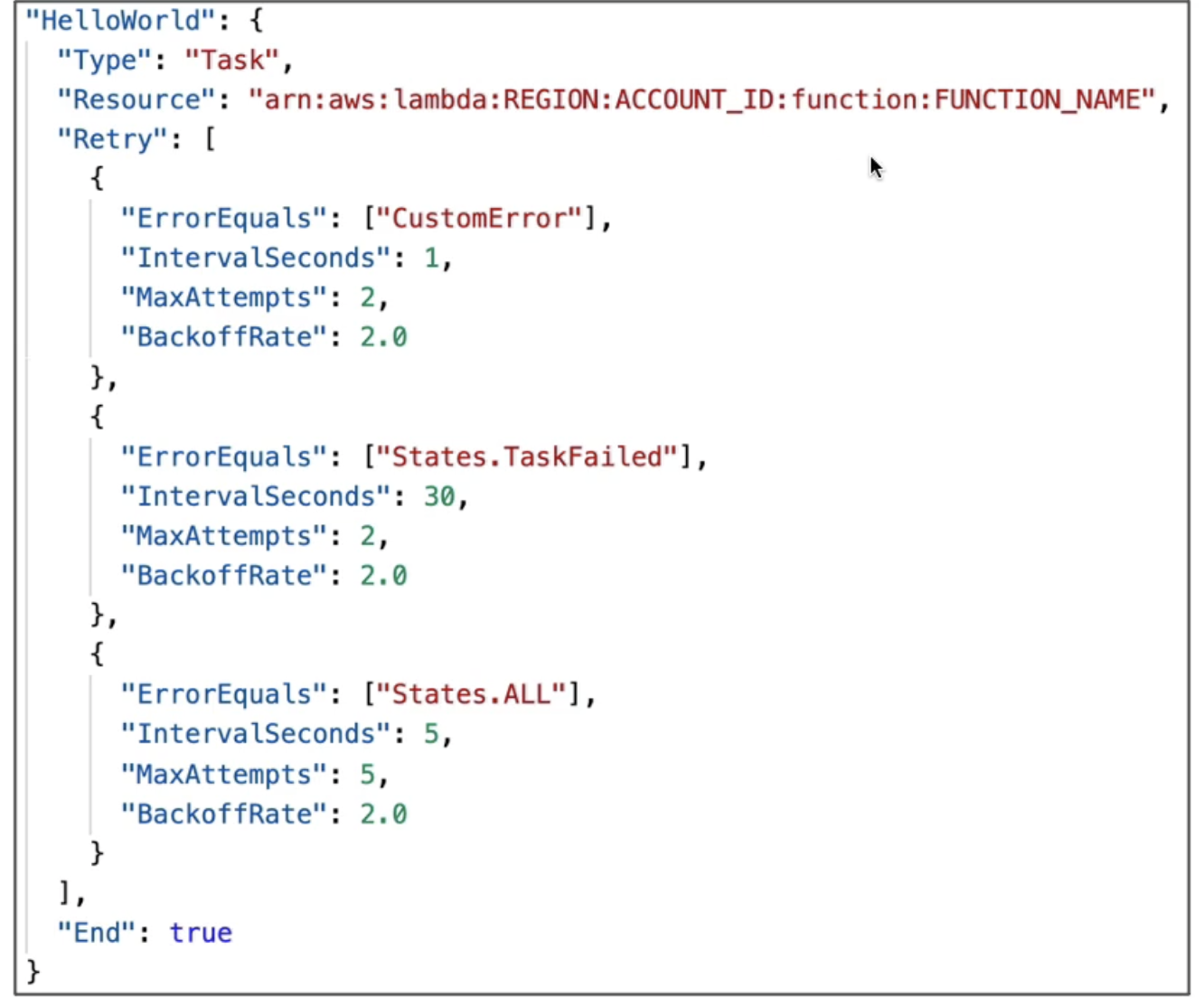
Catch: failure path when all retries fail
ErrorEquals: MAtch for error typeNextnext state for catch blockResultPath: Result to pass on to the next state. Used to pass error as input to next state

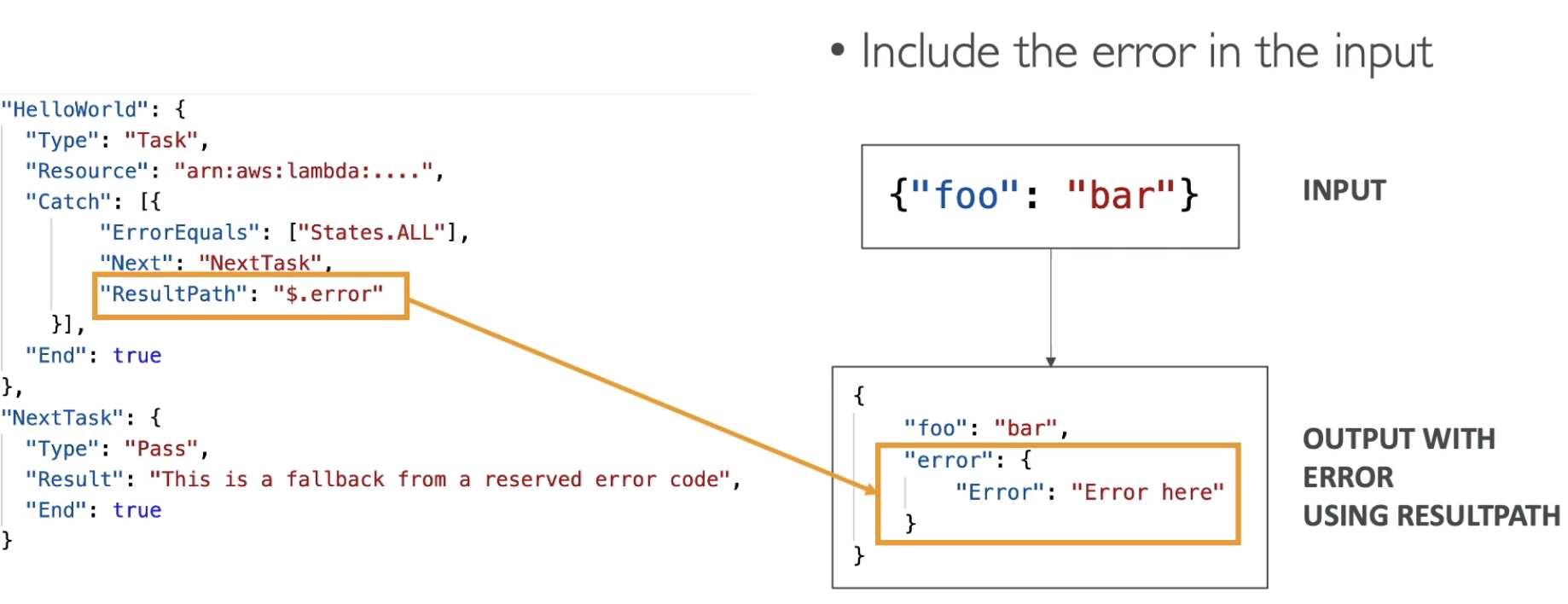
Amazon LIGHT SAIL
Simple Standalone service to host Wordpress like Site
- Great for people with little cloud experience
- Virtual Server to host sites, wordpress blog
- Low & predictable pricing
Amazon WORKSPACES
Managed Desktop as service (DaaS)
- Secure as integrated with KMS
- Deploy as close to work space to reduce latency
- eg. Use Windows/Linux Desktop on cloud
Amazon APPSYNC
Manged Graph QL Backendas Service to Store & Sync Data across mobile Apps & Web in real time
GraphQLas service combine data from one or more sources- local data access & synchronization
- Replacement for AWS Cognito Sync
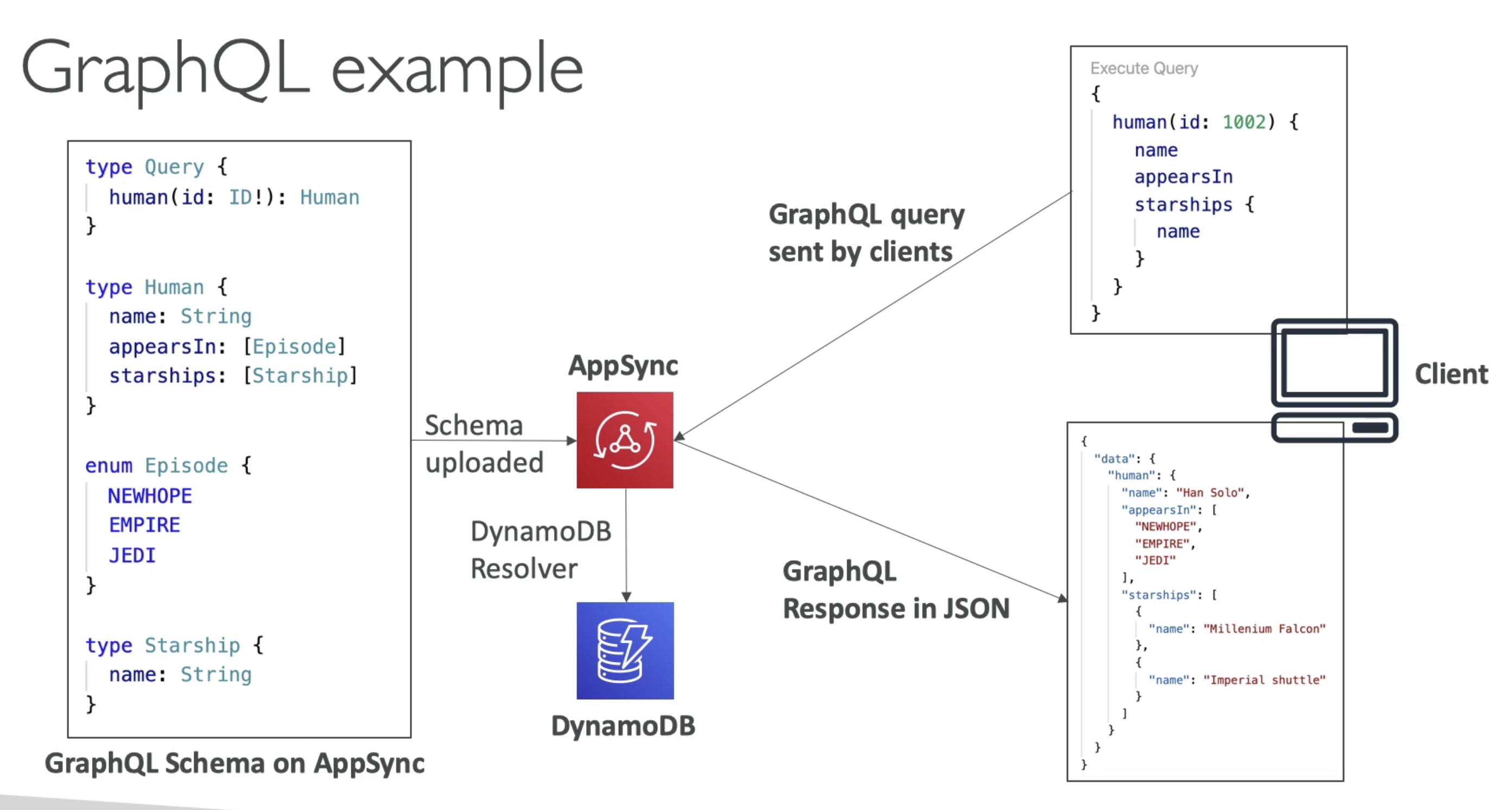
- Integrated with
Dynamo DB&Lambda - RealTime
Web SocketOr MQTT support
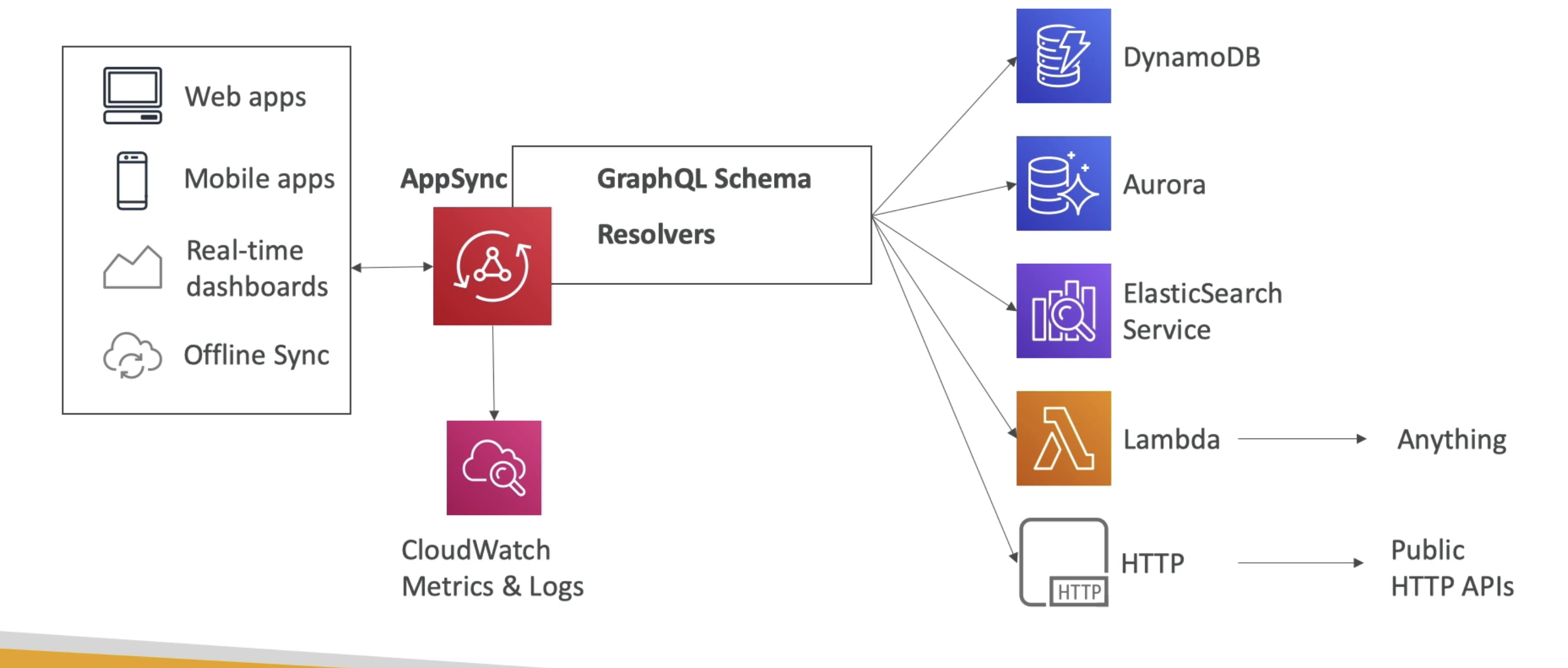
AppSync Security
- SSL using Cloudfront
- Analytics using CLoudWatch Log
- Authorize user for API using:
- API_KEY:
- IAM: IAM user & role
- OPENID_CONNECT: JWT Token
- COGNITO_USER_POOL: existing users
Amazon APPSTREAM 2.0
Desktop Streaming service to stream any app to any desktop without provisioning
- Run App on Browser
- Stream specific App instead of whole desktop
- Eg. Run Blender on Browser
Amazon SUMERIAN
VR/AR or 3D Model render on browser or in VR/AR headset
- Create 3D model with animation
- Render 3D scene on Web browser
Amazon IOT CORE
Connect IOT devices to AWS cloud
- Pub/Sub to communicate between devices
- Serverless,secure & scalable to billions of devices
- Backed by AWS services Suits
- Gather and process data from IOT devices
Amazon ELASTIC TRANSCODER
Convert media files on S3 to format required by consumer format
- Pipeline to process media file
- Scalable and easy to use
- Cost effective
- Manged & secure
DEVICE FARM
Fully manged service to test Apps on set of devices online
- Farm of devices connected to AWS cloud
- Test apps on tons of devices
- Take screenshots & interact with them
AWS ML & AI Services
-
Amazon Rekognition: Find image, TEXT, scene , object using ML in Images & Video
-
Amazon Transcribe: SPEECH to TEXT converter
-
Amazon Polly: TEXT to SPEECH converter
-
Amazon Translate: Localize large volume of TEXT to other language
-
Amazon Comprehend: Find Patterns in TEXT. Find language, sentiment, tokens & organize in topics.
-
Amazon Textract: Extract text from document
-
Amazon Lex: Engine powering Alexa
-
Amazon Connect: Receive calls and create contact flow eg CRM. Smart customer contact center
-
Amazon SageMaker: ML Platform to Train model.
-
Amazon Forecast: Create forecast based on historical data
-
Amazon Kendra: Extract answers from the document. Create a knowledge Index to create a search engine.
-
Amazon Personalize: provide recommendation based on user behavior.
-
Amazon Augmented AI(A2I): ML Platform to train model
-
Amazon Fraud Detector: Fraud Detection
-
AWS Ground Station: Satellite
Container Service
AWS Elastic Container Service (ECS)
Run and manage Docker Containers on AWS
- Must provision & Maintain EC2 Instance
- AWS take care of start/stop container & making sure desired number of tasks are running in EC2 fleet
- Charged based on EC2 Instance & EBS Volume used
- EC2 instance must run special AMI with docker preinstalled
- To enable random host port, set host port = 0 (or empty), which allows multiple containers of the same type to launch on the same EC2 container instance.
The cluster name Parameter has not been updated in the file /etc/ecs/ecs.config during bootstrap -
In the ecs.config file you have to configure the parameter ECS_CLUSTER='your_cluster_name' to register the container
instance with a cluster named 'your_cluster_name'.
ECS Scaling
CPU & Memory racked in CLoudWatch at Service Level
ECS have 2 level of scaling
1. ECS Service Scaling(Task Level):
Set cloud watch alarm to watch CPU usage/ SQS & launch new ECS Container
- Spin up new Container in EC2
2. Cluster Capacity Provider:(For EC2 Launch Type)
launch new EC2 Container when CPU usage go high of an EC2 Instance
- spin up new EC2 instance to spin container
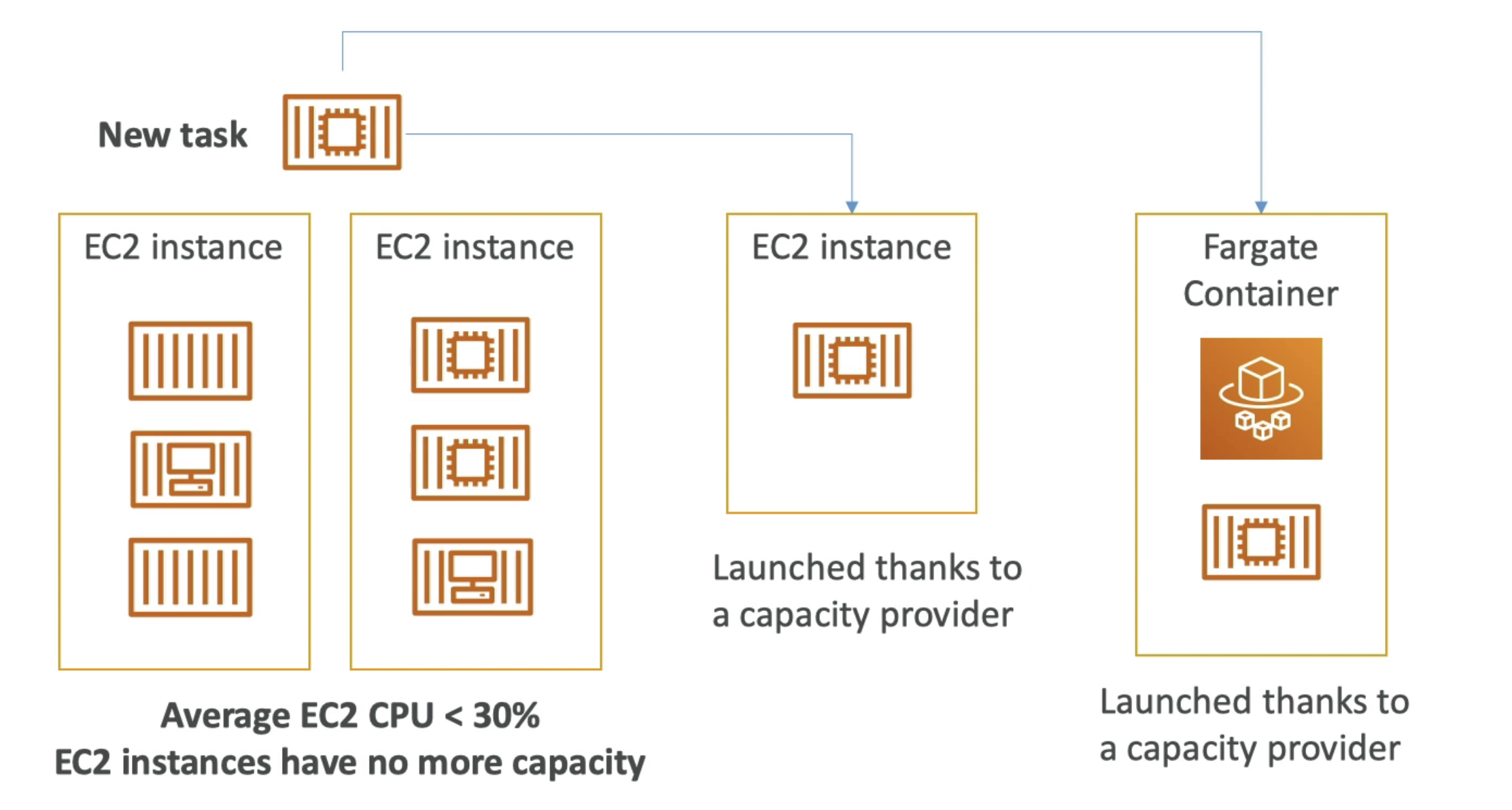
ECS Rolling Update
- Minimum Healthy Percentage: Min running Capacity
- Maximum percentage: New Task we can create to roll update

Integration with ELB, NLB, ELB:
Dynamic Port Forwarding: ALB Automatically find the right port to connect with ECS Cluster- ALB does the load balancing across ECS Containers
- ECS EC2 Security Group must allow Any Port coming form ALB to allow
Dynamic PortMapping possible with ALB
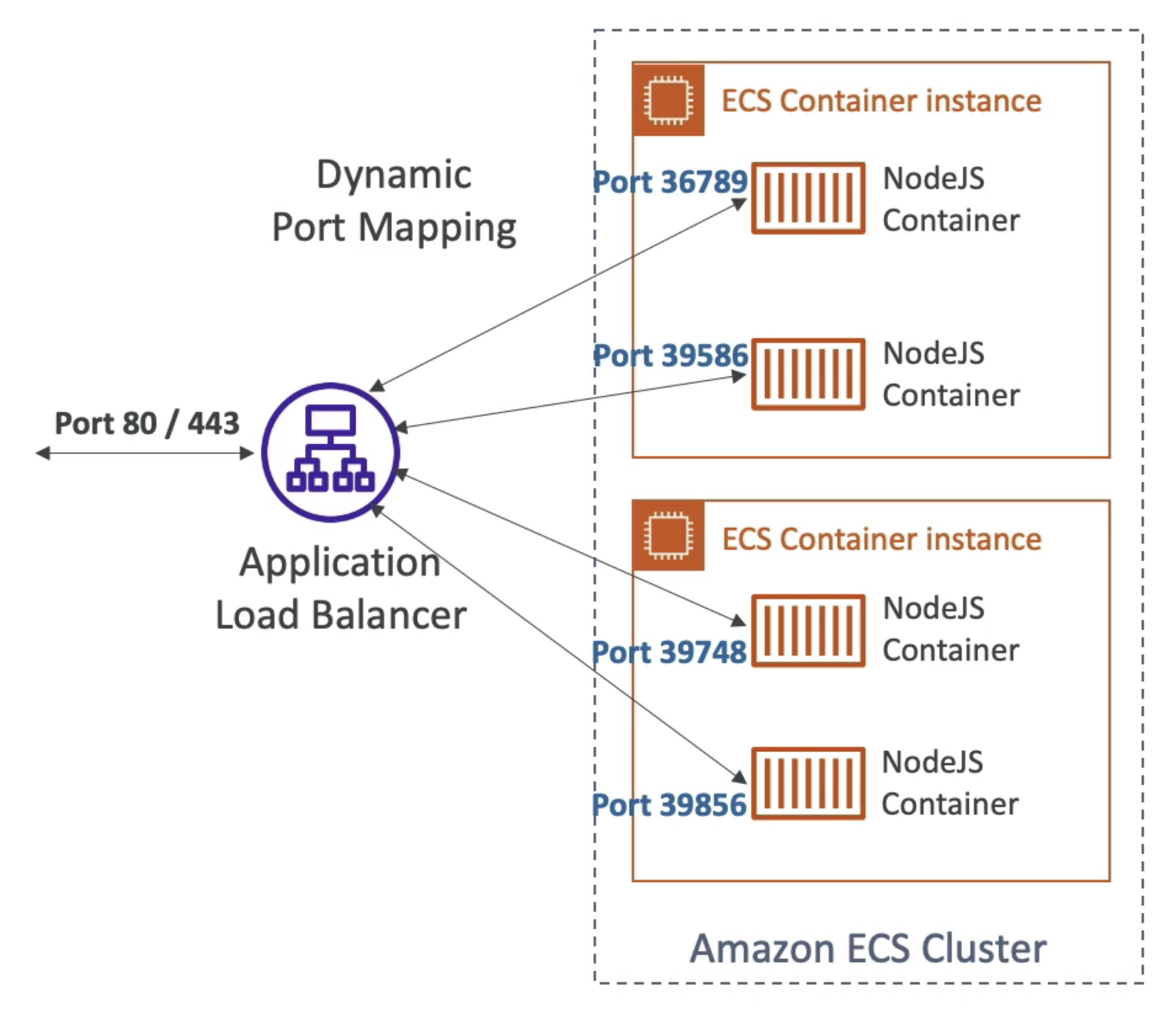
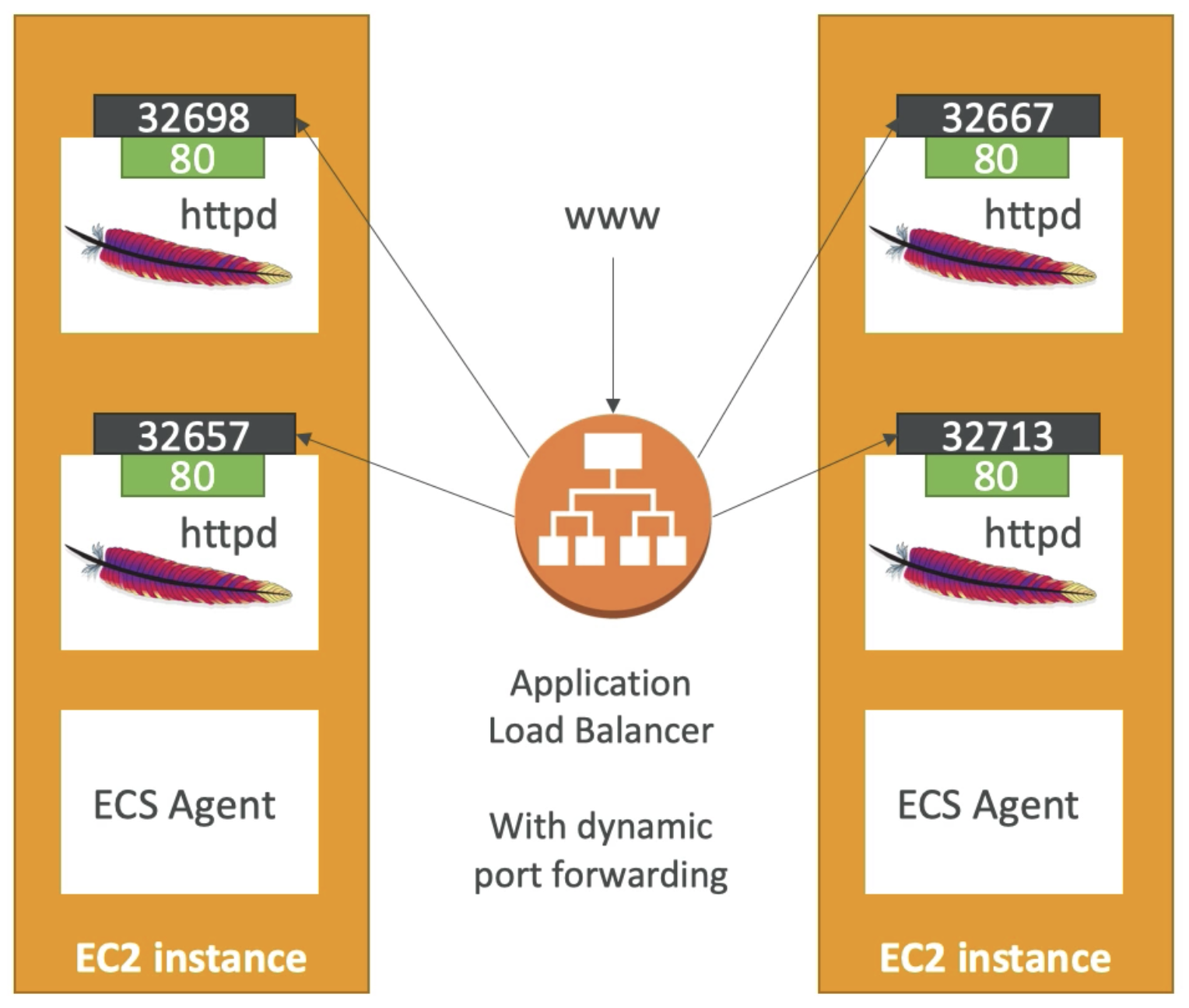
Task placement
Strategy to scale in/ out container
- Only for EC2 Launch Type
- Order of selection of EC2 instance to run ECS Task:
- Hardware requirements: CPU, RAM, port
Task Placement Constrain:distinctInstance: place in different Container instancememberOf: place based on CLuster Query Language eg instance type t2
Task Placement Strategy:BinPack: put as many container as possible in single EC2 instance- Good for cost saving
- based on CPU usage or Memory
- Maximize EC2 instance utilization
Random: Randomly place ECS in EC2 instancesSpread: Spread ECS in AVZ based on specified valueMixed: Mix above strategy
ECS Deep Dive
ECS Cluster: Regional logical grouping of EC2 instances
ECS Agent
Run on EC2 instances to create & register Docker Container
- Must run on EC2 instance to run ECS
Security:
- Secret Manager: Access Sensitive Data
- Access SSM Parameter Store
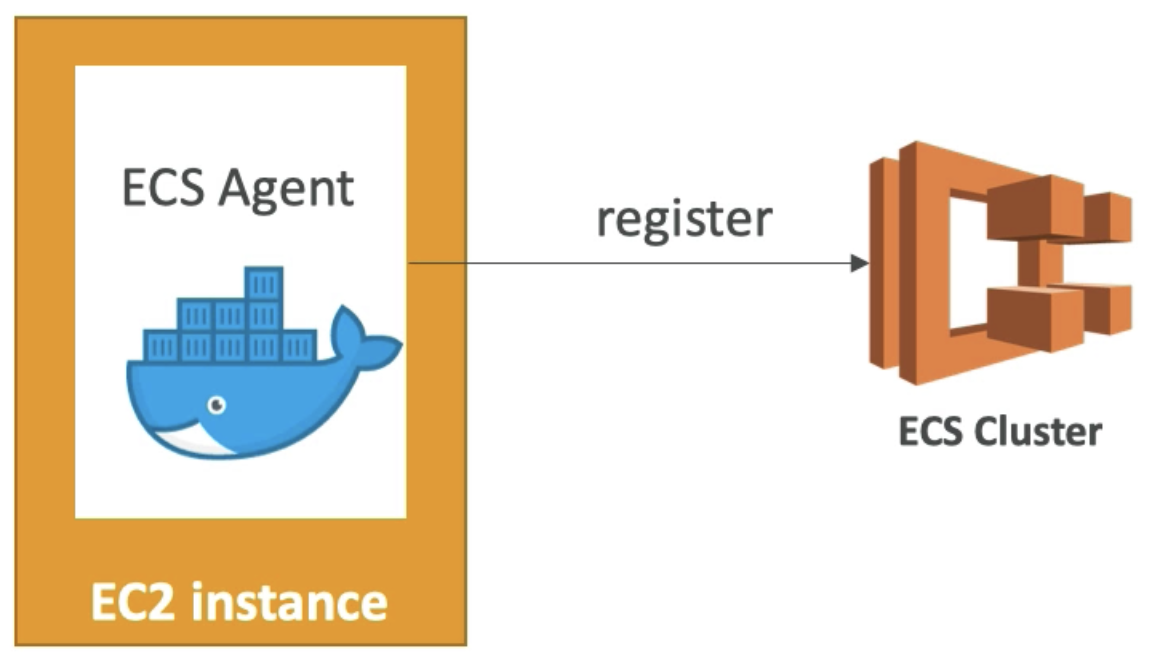
ECS task
start in EC2 instance by
ECS Agent
- Number of tasks in EC2 instance is decided on EC2 size
ECS IAM Roles
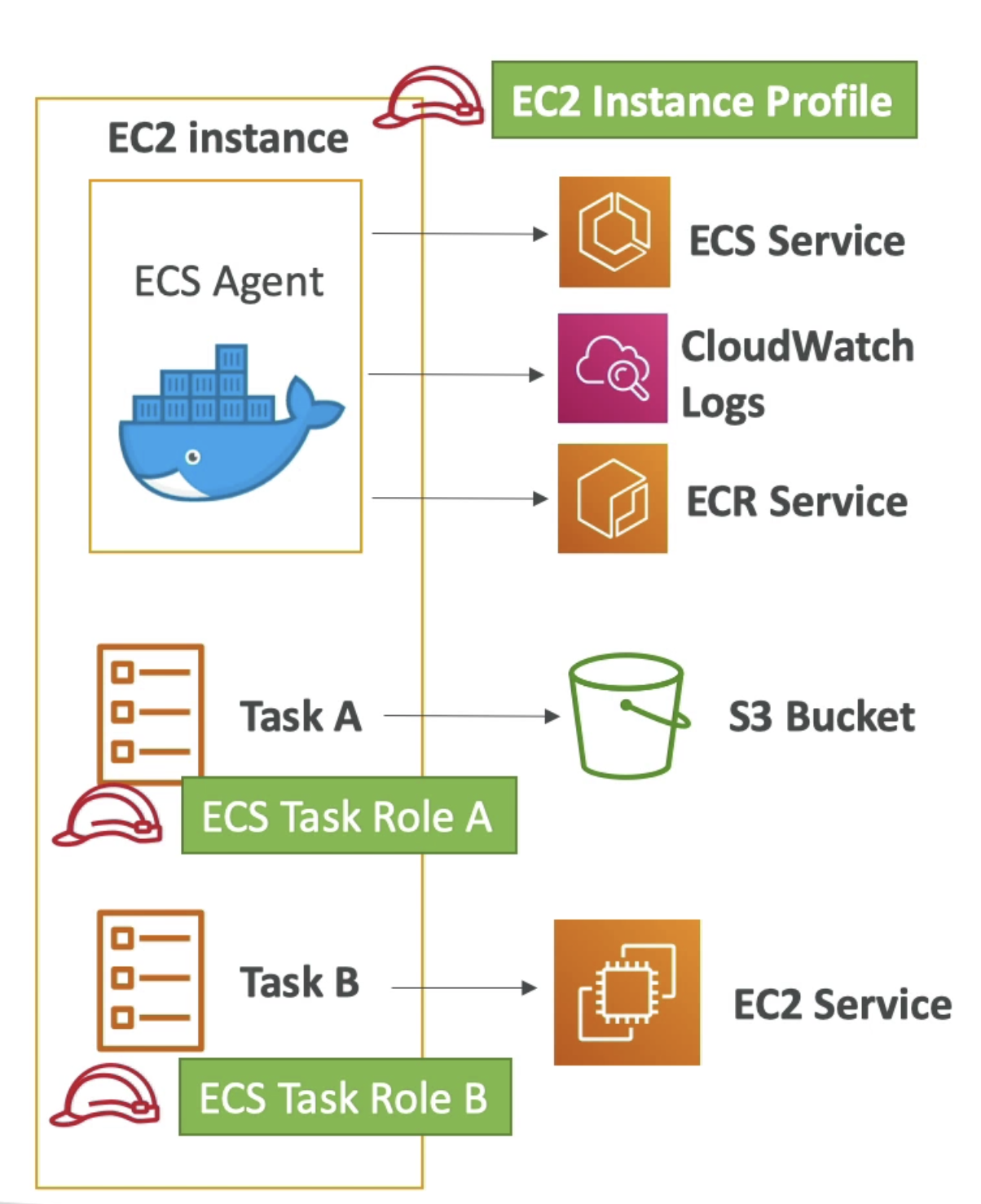
1. EC2 Instance Profile:
IAM role assigned to
ECS Agent
- Allows ECS Agent to
- Pull Docker Images from ECR
- Make API call to ECS
- Register instance to ECS Cluster
- Send Container logs to CLoudwatch
2. ECS Task Role:
IAMrole assigned to ECS Task to have specific role
- Create Separate TasksRole for Different Tasks
- Role is defined in
Task Definition
Task Definition
Metadata in
JSONfrom to tell ECS how to run a docker container
Metadata could be:
- Port Binding for Host & container
- CPU & RAm required
- Docker Image Name
- network Information
- Environment variables
Deregister ECS Container:
- Terminate the container from
RUNNINGstate: container instance is automatically removed, or deregistered, from the cluster. - Terminating ECS container from
STOPPEDstate: container instance isn't automatically removed from the cluster. You will need to deregister your container instance in the STOPPED state by using the Amazon ECS console or AWS Command Line Interface.
ECS Data Volumes
1. EBS
EBS can be unmount & Mount to ECS in 1 AVZ
- Give temporary extra storage
- If Task moved to other EC2 instance data become useless
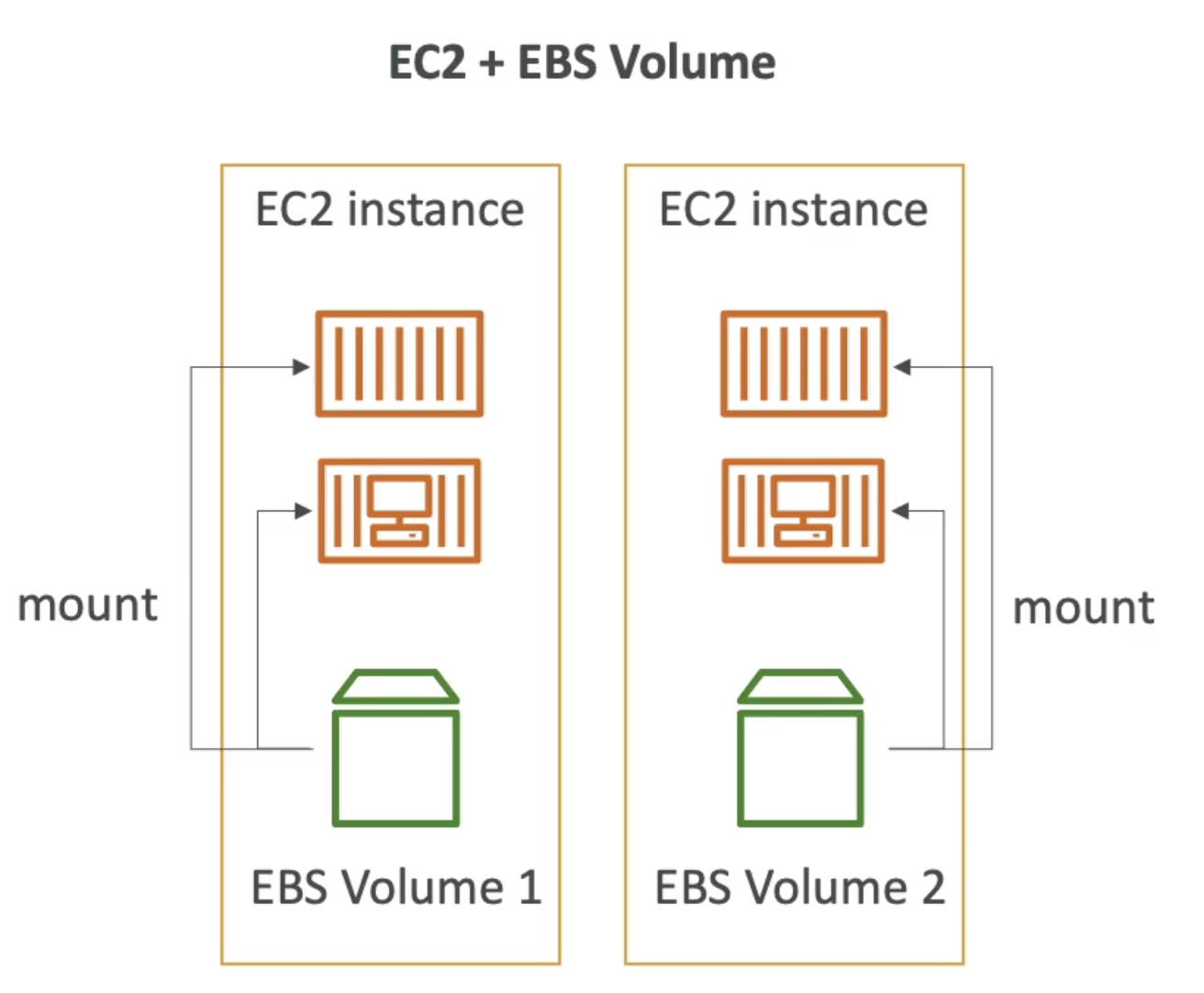
2. EFS
EFS File System can be mount to multiple ECS
- Works with both EC2 & fargate Launch type
- Persistent across Multi AZ with Shared Volumes for ECS Container
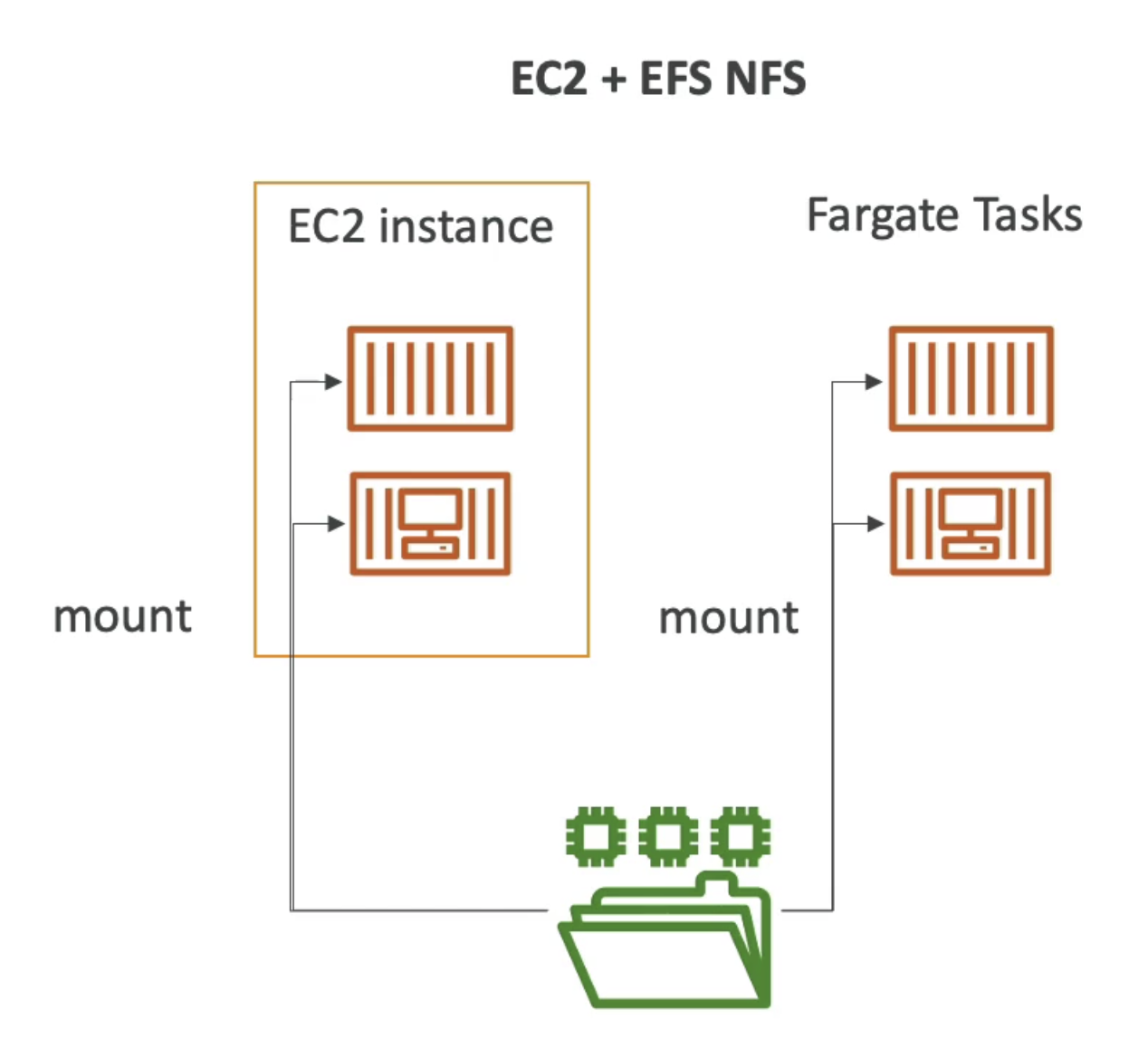
3. Bind Mount
Shared between containers in one ECS Task
- One container write data & other can read from it
- Works with both ECS & Fargate(4GB of Volume Mount)
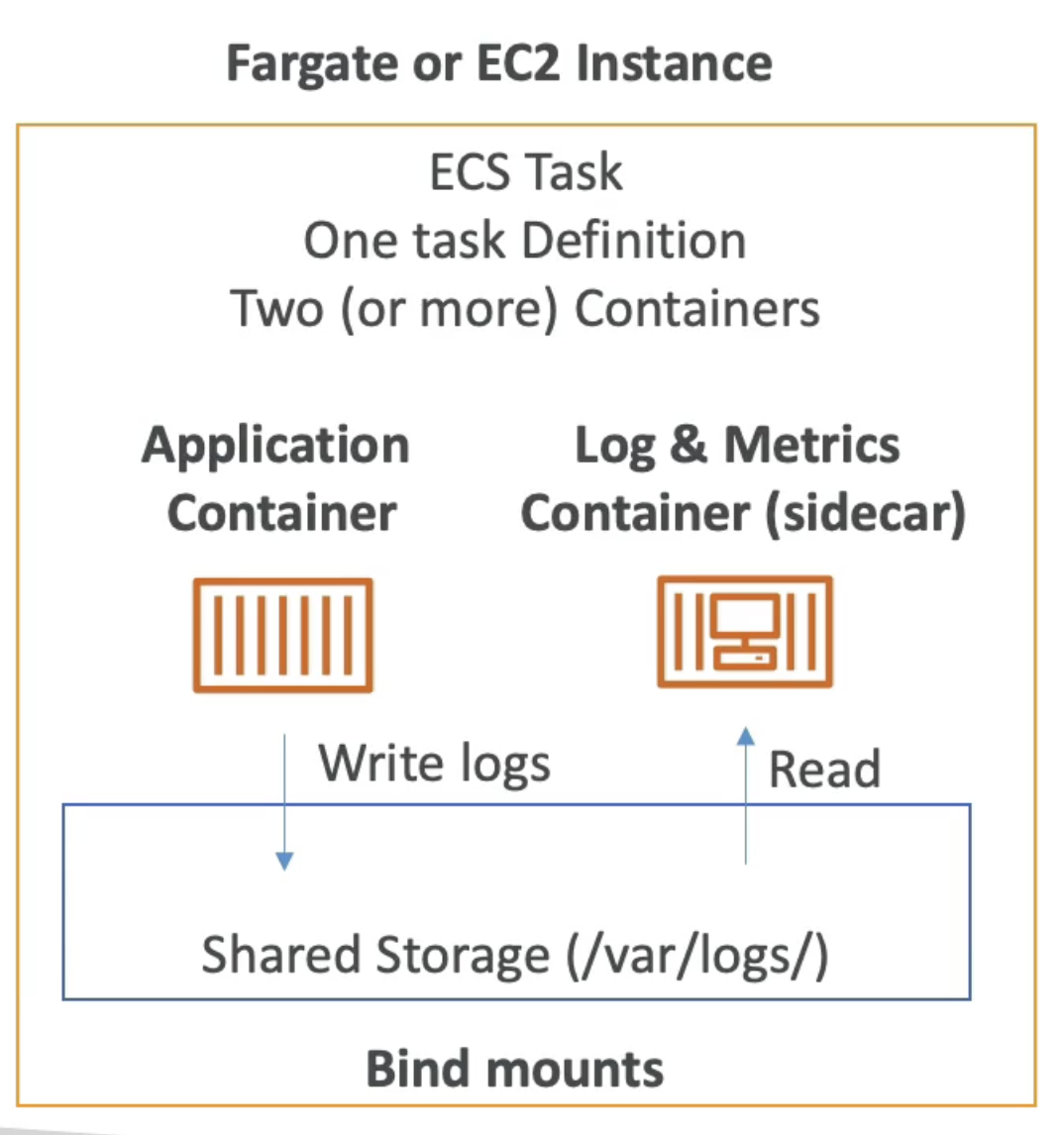
Launch Types for ECS
1. EC2 Launch Type
Must provision & Maintain EC2 Instance
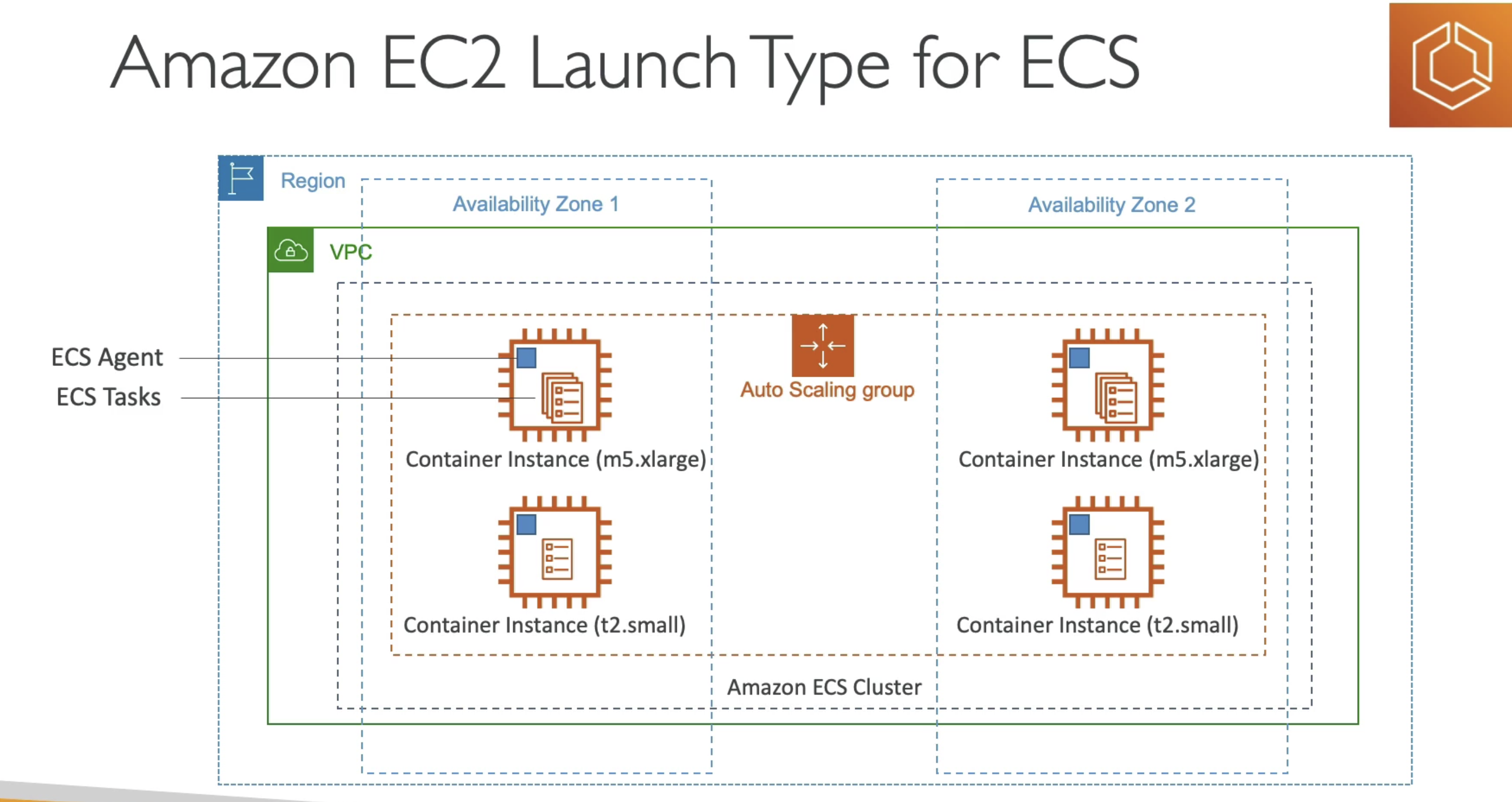
2. FARGATE Launch Type
Serverless compute platform for ECS & EKS
EFS+Fargate= True Serverless- No need to create EC2 instance: AWS automatically provision server based on CPU/RAM
- Each task get unique Io address using ENI(Elastic Network Interface)
- Task Port from ALB must be allowed in ENI security group to allow Load Balancing
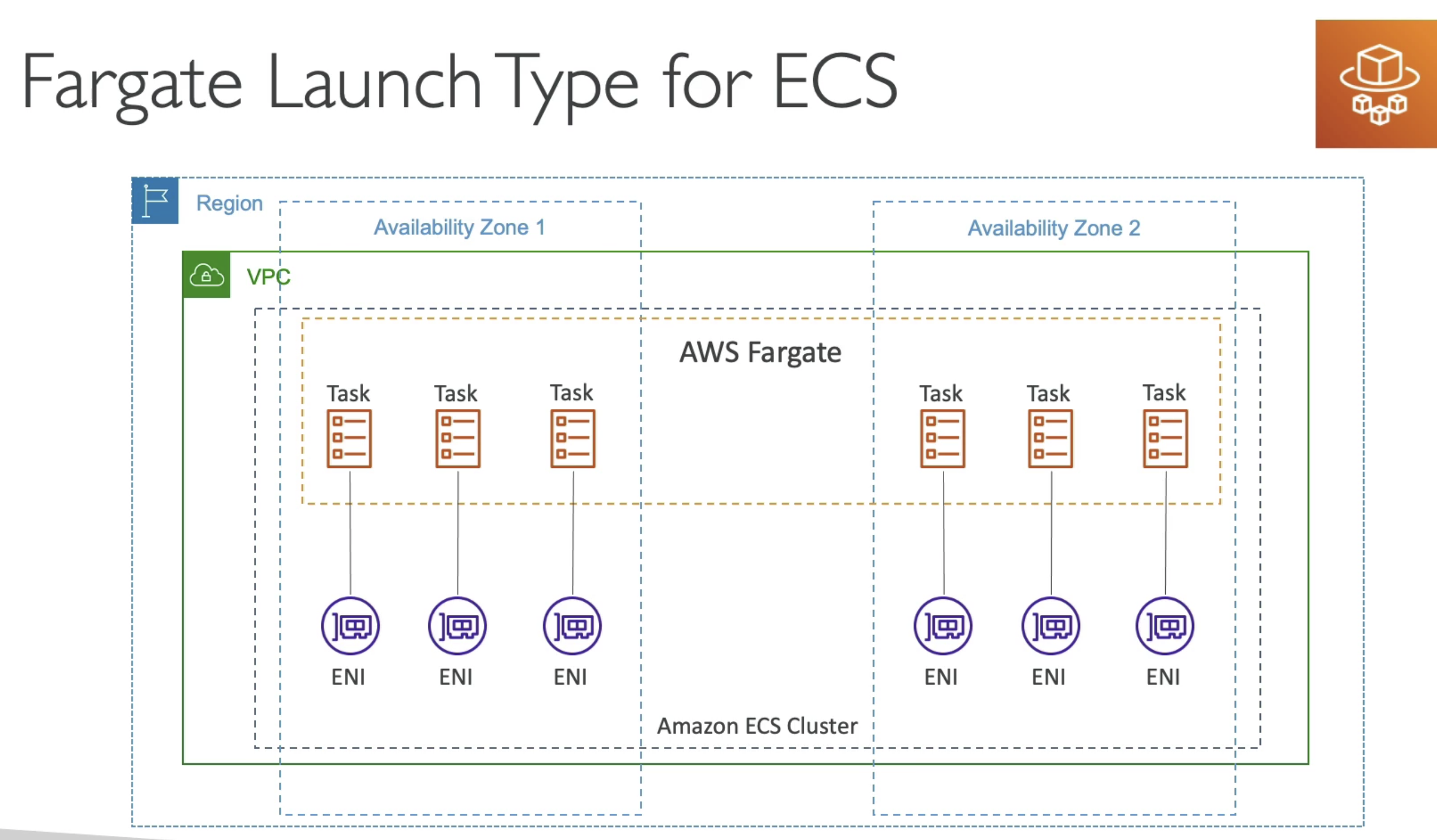
AWS Elastic Container Registry (ECR)
Private docker registry used by fargate and ECR to store, manager , deploy docker image
- Use
IAMfor security & backed byS3 - Can be automated using Code Build
- CLI login v1 use
$while v2 usepipe |
Command Pull docker image
// Login into ecr to get access token for 12 hour
$(aws ecr get-login --no-include-email)
// Pull Image
docker pull 1234567890.dkr.ecr.eu-west-1.amazonaws.com/demo:latest


AWS Elastic Kubernetes Service(EKS)
Launch Managed Kubernetes cluster on AWS
- Can use EC2 and fargate deploy mode
- Kubernetes can be deploy to any cloud Infra
- Charged based on vCPU & Memory used
